Barcelona, a city with a rich cultural heritage, was heavily influenced by Antonio Gaudi's works, including Park Guell and the unfinished La Sagrada Familia church. The city offers a mix of Roman ruins, Gothic architecture, and modernista design, with famous landmarks like Casa Balto. Visitors can explore the city's historic sites, street performers on La Ramblas, and affordable prices for some attractions, making it an excellent destination to experience Barcelona's unique culture and architecture.
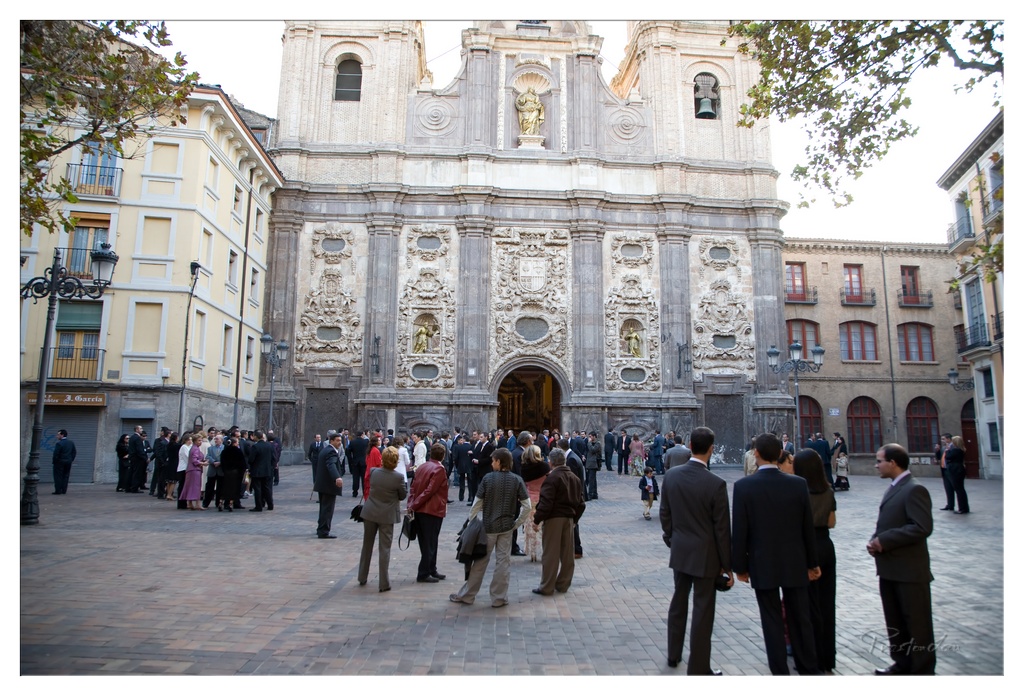

Anticipation at the Abbey Doors
Subject Rating: 7/10
In this scene, a throng of formally dressed individuals congregates on a vast, patterned stone plaza before the magnificent, highly ornamented facade of a grand building, likely a church or cathedral. The air feels expectant, suggesting they are gathered for a significant event, perhaps a wedding or important service. People stand in small groups, conversing or simply waiting, their dark suits and formal dresses creating a sea of solemnity against the pale stone and autumnal leaves visible overhead. The building itself is the dominant backdrop, featuring intricate carvings, statues in niches, and prominent arches, all dwarfing the human activity below. Flanking this central structure are two other buildings: a multi-story yellow one with balconies on the left, housing a shop on the ground floor, and a brown brick building with numerous windows and arched entrances on the right, adding context to the urban square setting.
From a photographic standpoint, the composition is a wide-angle attempt to capture the entire scene, showcasing both the impressive architecture and the assembled crowd. The slightly tilted horizon line is a curious choice – perhaps intentional to add dynamic energy, or just a happy accident of a handheld shot capturing a busy moment. The lighting is soft and diffuse, hinting at late afternoon, which is kind to the textures of the buildings and the pavement, though it provides little dramatic shadow or highlight on the crowd. Capturing a large group like this presents the perennial challenge of finding compelling individual moments amidst the collective, and while the main subject is clear, the overall impression is one of general milling rather than specific interaction. It perfectly encapsulates that pre-event moment – everyone's here, dressed up, but the main show hasn't started, leaving them to perform the delicate dance of polite public waiting.
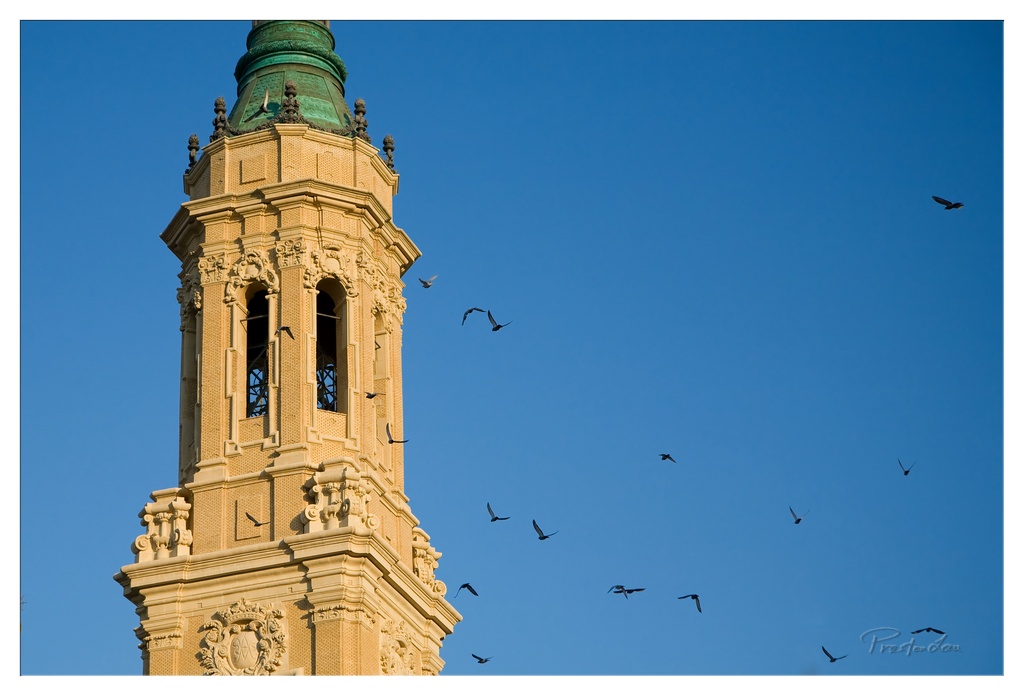

Towering Presence and Aerial Ballet
Rating: 7/10
This photo presents a grand architectural subject, a stately tower adorned with intricate carvings and topped with a weathered green dome, commanding the left side of the frame. The real action, however, is provided by a flurry of birds executing what appears to be an unchoreographed aerial performance around the tower and across the vast blue stage of the sky. The mood balances the timeless dignity of the stone structure with the fleeting, dynamic energy of the flying creatures. It's a classic scene you might encounter in a European city square – majestic architecture meets everyday urban wildlife, making for a photograph that feels both historical and immediately lively.
Looking at the technicals, the composition opts for an off-center placement of the tower, anchoring the left side and leaving a large area of clean blue sky on the right. While this uses negative space effectively, one can't help but wonder if the rest of the building was hiding just out of frame, perhaps shy. The lighting suggests strong sunlight, likely from the side or back, which beautifully illuminates the tower's textures but creates significant contrast and renders many of the birds as dark silhouettes against the bright sky – a common challenge when shooting dynamic subjects against a bright background. The color palette is dominated by the warm, golden hues of the tower and the striking blue of the sky, a simple but pleasing combination that lets the shapes stand out. The scattered flock of birds adds necessary points of interest and movement to the otherwise static scene and expansive background, preventing the sky from feeling too monotonous. It's a solid capture, capturing the life around the monument, even if the tower's placement feels slightly... left behind.
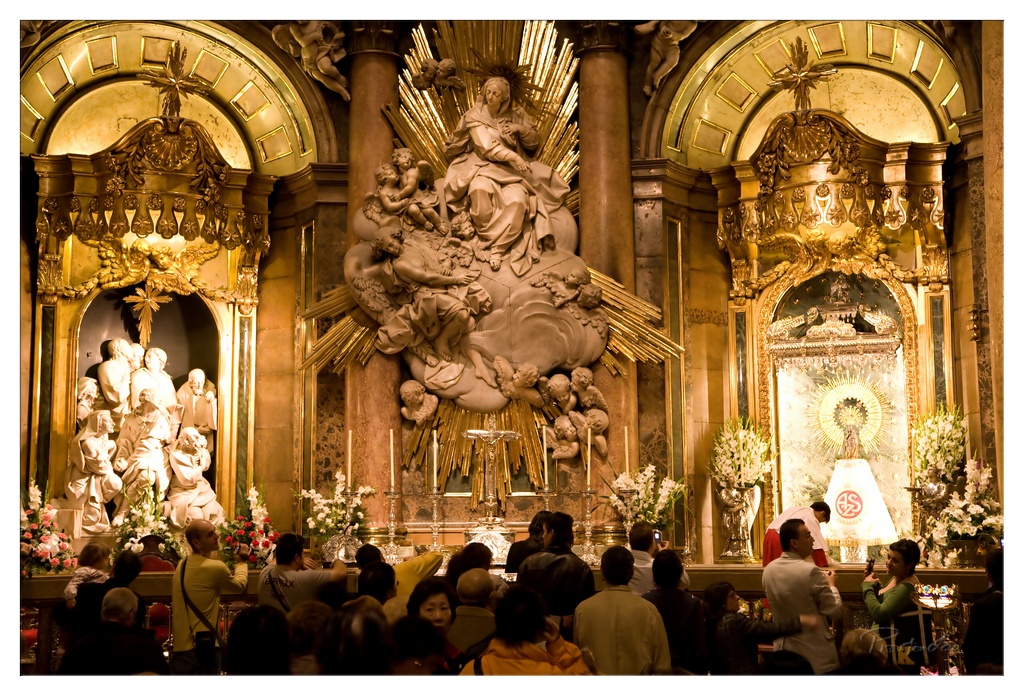

Baroque Bling and Beholders
Subject Rating: 9/10
This scene is a lavish feast for the eyes, set within the opulent interior of a church, likely dripping in Baroque splendor. Dominating the frame are three grand religious displays. The central and most dramatic piece is a magnificent marble sculpture depicting the Virgin Mary amidst a cloud of angels, bathed in an almost theatrical golden light emanating from a radiant sunburst behind her. To her left, an alcove hosts a solemn group of sculpted figures, seemingly engaged in a devotional scene, while the right side features a smaller, yet equally ornate, shrine with a radiant image, hinting at another revered artifact. The sheer scale, intricate detail, and abundant use of gold and marble in these structures are breathtaking, easily earning the subject matter a high rating for its artistic and architectural significance. Below this divine tableau, a crowd has gathered, their presence adding a sense of scale and modern context to the timeless setting.
The photograph captures a moment of busy reverence, where devotees and visitors mingle in awe of the artistry. From a photographic standpoint, the composition attempts to showcase the grandeur of the altars, though the sea of people in the foreground inevitably becomes part of the scene, obscuring the lower portions of the structures and adding visual noise. The lighting, while dramatically highlighting the central sculpture's golden rays and features, creates stark contrasts, leaving many faces in the crowd shadowed. It’s a classic challenge of capturing a vibrant public space – you get the atmosphere, but you also get folks holding up phones to snap their own memories, perhaps asking if the cherubs are visible through the lens flare. Despite these challenges, the image successfully conveys the overwhelming beauty and spiritual intensity of the location, portraying a moment where ancient faith and ornate art are actively engaged by contemporary life.
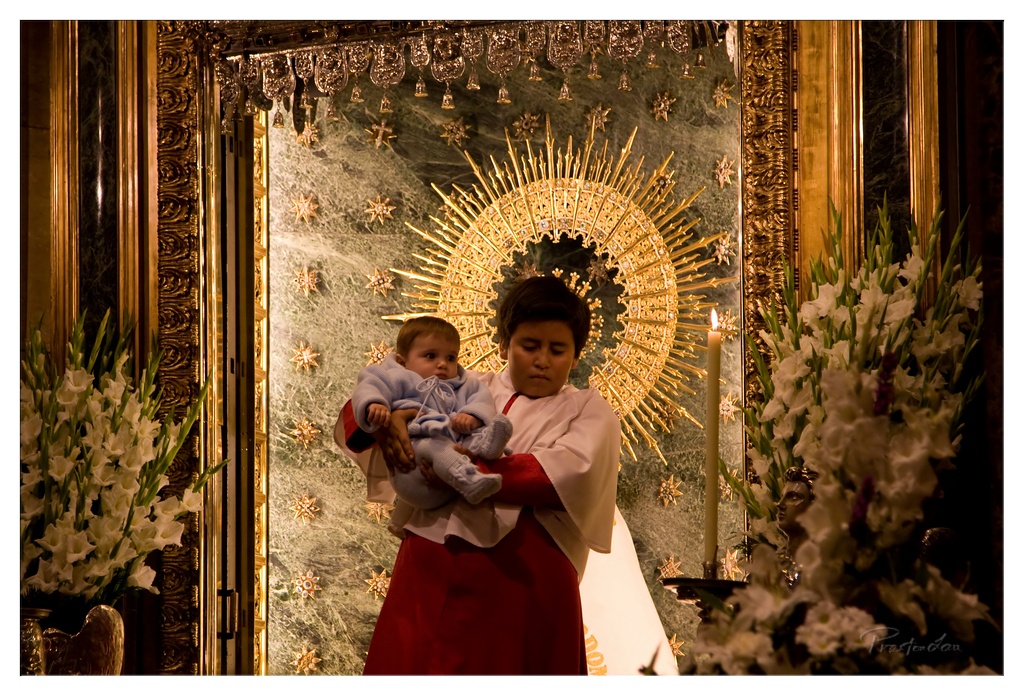

The Divine Embrace (and Maybe a Little Back Strain)
Subject Rating: 8/10
This image presents a moment of solemn duty, capturing a young man or boy holding a baby in what appears to be a religious setting. Our central subjects are the boy, looking rather serious and focused, perhaps concentrating on not dropping the precious cargo, and the baby, bundled in blue and looking a little wide-eyed, possibly contemplating the sheer amount of gold behind them. The mood is undeniably reverent, perhaps a bit tense given the boy's expression, set against an incredibly ornate background suggesting a significant religious icon or altar piece. Flanked by towering arrangements of white gladioli and illuminated by a single, slender candle, the scene feels both grand and intimately focused on the two figures.
From a photographic perspective, the dramatic lighting is the star, employing what looks like focused spotlights to pick out the figures and the dazzling golden sunburst structure behind them, plunging the rest of the scene into shadow. This high-contrast, low-key approach creates a palpable sense of drama and highlights the textures of the opulent background – the rich, green marble-like surface studded with golden stars and framed by heavily decorated pillars. Compositionally, the subjects are placed slightly left of center, balancing the lit candle on the right, though the dominant vertical lines of the frame and flowers create a sense of height and grandeur that perhaps visually outweighs the central figures slightly. The rich color palette, dominated by gold, deep red, and the cool green, adds to the luxurious, almost theatrical feel, making this shot a study in capturing a specific, intense moment within a highly stylized environment – just try getting that baby to smile when you're aiming a floodlight at them!
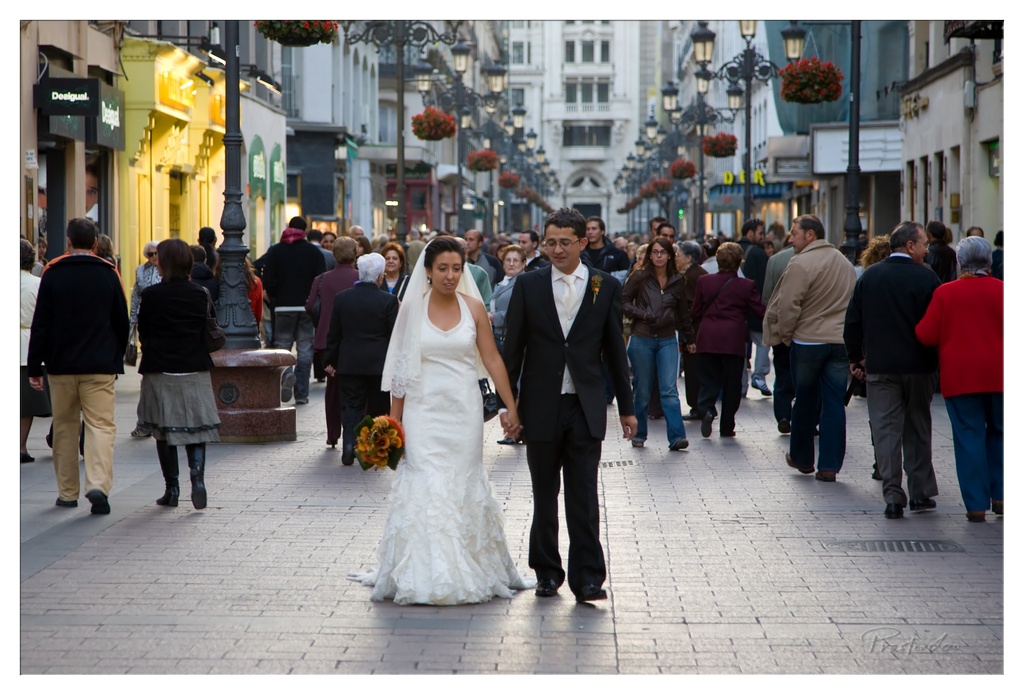

Street Pomp and Circumstance
Subject Rating: 10/10 (For the sheer audacity of navigating a crowded street in wedding finery)
Ah, the classic post-nuptial promenade! This shot captures a newly married couple, radiant and perhaps slightly bewildered, making their way through a bustling pedestrian street. Hand-in-hand, the bride in her flowing white gown and veil clutches a vibrant bouquet of sunflowers or similar blooms, while the groom cuts a sharp figure in his dark suit with a boutonnière. The mood is undeniably celebratory, tinged with the vibrant energy of the city crowd. It's a bold move, walking a gauntlet of onlookers and shoppers right after saying "I do," but they wear it well, seemingly unfazed by the dozens of fellow citizens sharing their big moment and providing an impromptu wedding parade backdrop.
From a photographic standpoint, the composition here cleverly uses the street as a leading line, drawing the eye towards the receding perspective and the architectural backdrop, punctuated by the repeated pattern of ornate lampposts and hanging flower baskets. The couple is placed centrally, though perhaps a tiny bit further left than strictly necessary, forcing the photographer to embrace the surrounding crowd as a significant part of the narrative rather than just background noise. The natural light appears soft but directional, nicely illuminating the couple while creating interesting shadows on the cobblestone-like pavement. The color palette is a warm blend of brick tones, building facades, and the pops of red and orange from the flowers and bouquet, grounding the formal attire of the couple in the casual urban environment. It's a candid, lively capture that speaks volumes about celebrating love amidst the beautiful chaos of everyday life – and maybe gives future couples ideas about how to make a truly memorable exit (or entrance!).
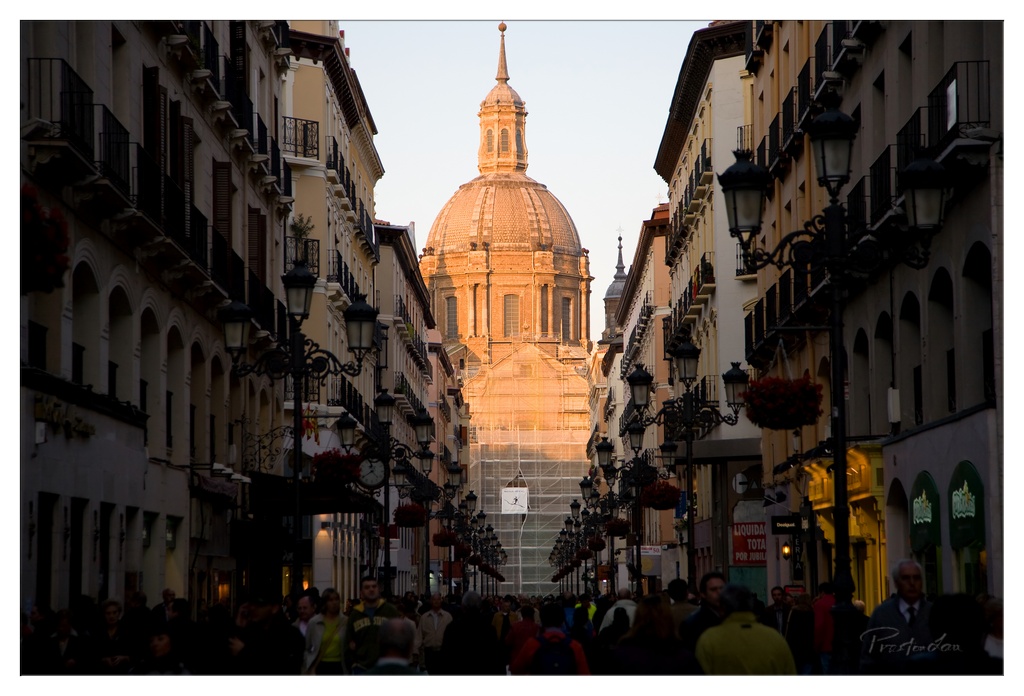

Street Scene Leading to Grand Dome
Subject Rating: 8/10
This photograph plunges us into the bustling heart of a European city street, drawing the eye inexorably towards the magnificent dome of what appears to be a grand church or cathedral bathed in warm, late-day sun. The scene is framed dramatically by tall, ornate buildings lining either side of the street, their darker facades creating a natural canyon effect that guides our gaze towards the brightly lit architectural masterpiece at the end. Below, a throng of people navigates the pavement, their presence adding a layer of everyday human activity against the backdrop of timeless architecture. The mood is one of awe juxtaposed with the mundane, a classic urban tableau where grand structures stand as silent witnesses to the constant flow of life.
The composition is strong, utilizing perspective to create depth and emphasize the scale of the dome relative to the street level. The lighting is arguably the star here, dramatically illuminating the dome's rich, warm brickwork and casting long shadows that add contrast and shape to the scene, though it leaves the foreground a bit dark and the people slightly obscured. The row of decorative street lamps marching down both sides adds visual rhythm and reinforces the leading lines. While the grandeur of the dome is impressive, the presence of scaffolding reminds us that even icons require maintenance, a touch of reality in an otherwise almost idealized view. Despite the challenging low light in the foreground, the photograph successfully captures the vibrant energy of the street and the majestic presence of the landmark, making for a compelling visual narrative.
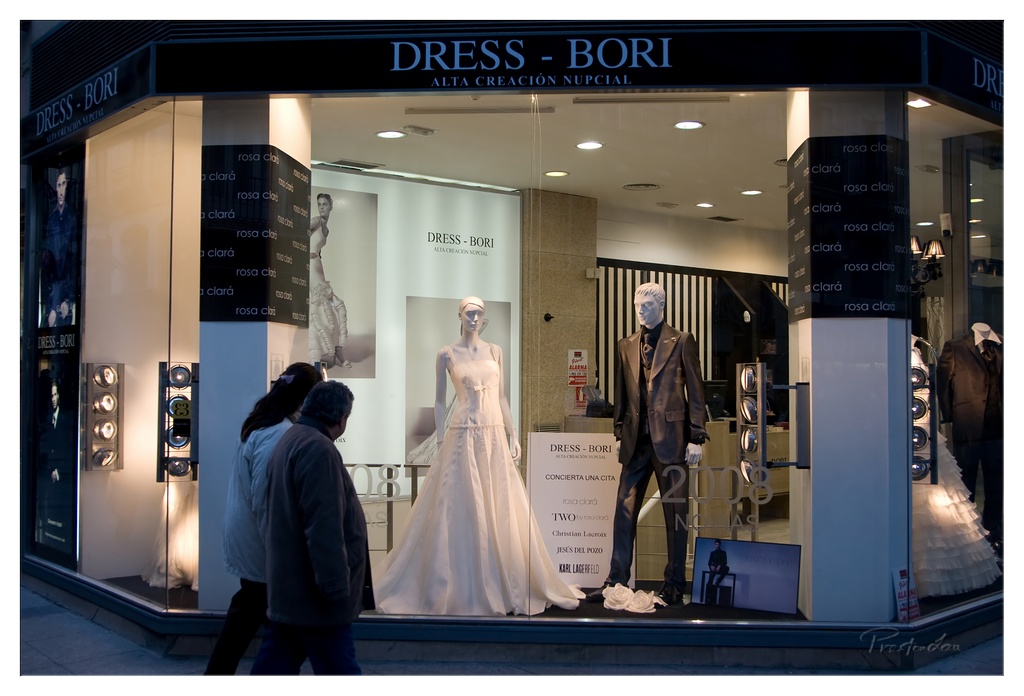

Window Shopping Dreams (and Reflections)
Subject Rating: 7/10
This image captures a classic retail street scene, focusing on the illuminated window display of "DRESS - BORI ALTA CREACIÓN NUPCIAL". The subject matter, a glamorous formal wear shop specializing in wedding attire, scores well for its aspirational content, but the slightly detached nature of the mannequins and the busy, reflective glass keep it from a perfect score. What's happening is the daily dance of commerce: people strolling past, perhaps pausing to admire the frocks and suits that promise a grand occasion. The mood is a mix of aspirational fantasy inside the window and the gritty reality of the street outside, tinged with the slight chill of evening.
From a photographer's perspective, the composition effectively uses the large storefront window as the primary frame, drawing the eye to the central figures – the mannequins. The inclusion of the two people walking in the foreground adds a human element and a sense of scale, disrupting the static perfection of the display, perhaps even suggesting the target audience or just casual observers. Lighting is a key element; the bright interior spot and ambient lighting dramatically highlight the wedding dress and the groom's suit, creating a strong contrast with the darker street outside. However, the strong interior light also creates significant reflections on the glass, which, while adding a layer of complexity and showing glimpses of the street, also obscure parts of the display and add visual clutter. The color palette is dominated by bridal whites, formal blacks and greys, and the warm tones of the interior lighting and reflections. The style feels like spontaneous street photography, capturing a moment as people interact with a staged commercial environment. Pertinent objects include the "rosa clara" branding on the column, the prominent list of designers (Rosa Clará, Christian Lacroix, Karl Lagerfeld!), and the alarm system sign – mundane details contrasting with the high-fashion display. The background is primarily the shop interior itself, showcasing its neat arrangement and striped wall, overlaid with reflections of the exterior street and whatever lights might be opposite. It's a solid capture of a typical, albeit stylish, urban retail encounter.
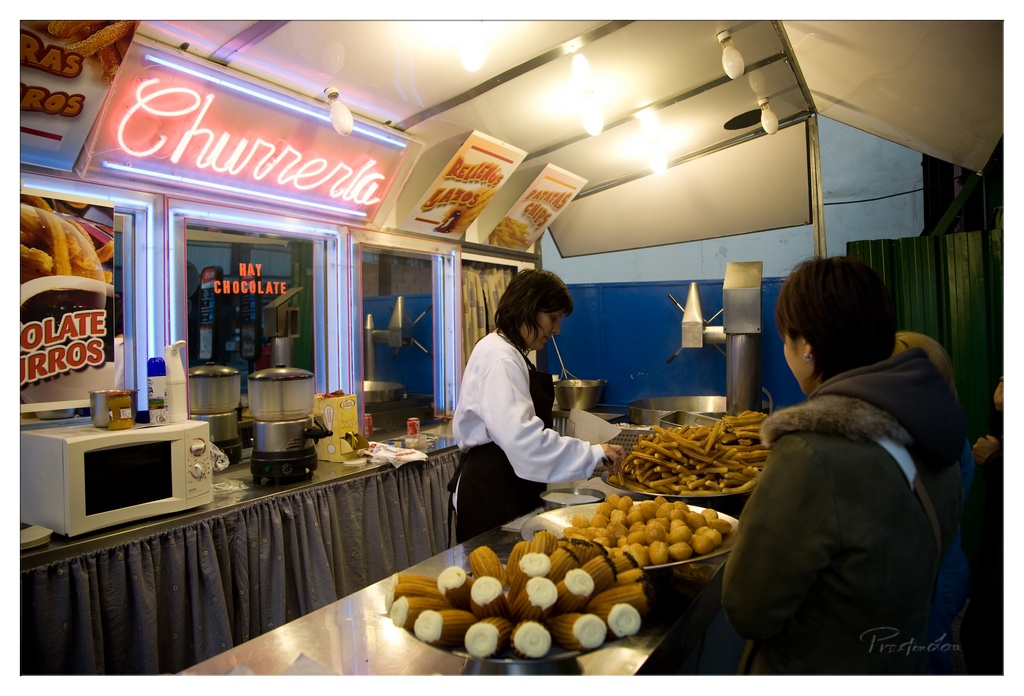

Late Night Carb-Fest Under the Neon Glow
Subject Rating: 9/10
Ah, the siren song of fried dough, captured perfectly under the warm, albeit slightly aggressive, glow of a neon sign proclaiming "Churreria"! This scene is a delightful dive into the world of Spanish (or similar) comfort food at night. We see a bustling churro stand in action, a culinary haven where crispy goodness is being conjured. A worker diligently handles the goods, likely fresh from the fryer, while customers queue up, eyes wide with anticipation for their sugary, oily fix. The mood is undeniably warm and inviting, the kind of place you stumble upon late at night and suddenly realize you absolutely *need* a bag of churros (or maybe three). The composition, while a tad chaotic, effectively draws the eye along the counter piled high with golden treats and towards the promise of more behind the busy proprietor. It feels authentic, like a moment stolen from a lively street or market.
From a photography perspective, the lighting is the star here – literally. The bright neon sign and interior lights create a high-contrast, slightly harsh but incredibly effective look that screams "night market food stall." It highlights the textures and colors of the fried food beautifully, making it look utterly irresistible, even if the shadows are a little deep in places. The color palette is rich, with the warm browns and yellows of the churros contrasting with the cool blues of the stall and the glowing pink of the sign. It's not a technically perfect shot, but its strength lies in its ability to capture the atmosphere and the irresistible subject matter. The foreground detail of the perfectly arranged churros and other fried snacks adds a delicious layer, almost making you want to reach into the photo. The industrial equipment and simple counter design in the background add to the feeling of a no-nonsense operation focused purely on delivering fried happiness. It's documentary style street food photography at its finest – messy, real, and mouthwateringly good.
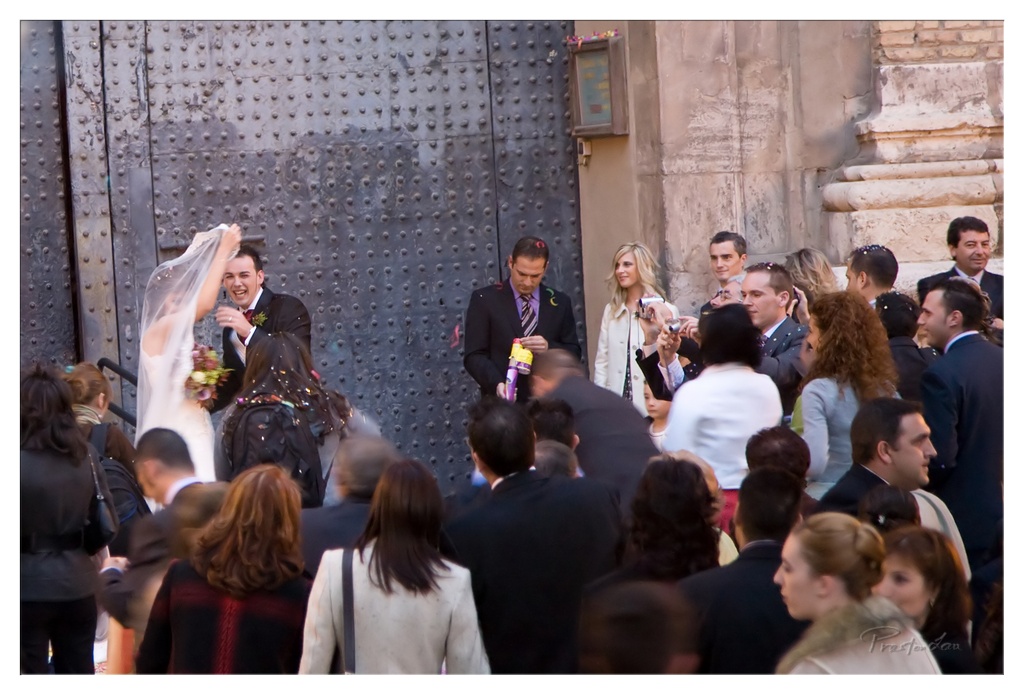

Confetti Chaos Exit Strategy
Subject Rating: 8/10 (A lively, classic wedding moment full of potential!)
Welcome to the post-ceremony rush, captured here in a moment of glorious, confetti-fueled chaos. The scene is set against a massive, imposing door – likely the grand exit from wedded bliss – and the weathered stone facade of a building. We see a crowd of guests participating in the tradition of showering the newlyweds with celebratory debris. On the left, a joyous bride and groom, veil flowing, look absolutely thrilled by the onslaught. Further right, another figure in a suit appears to be actively involved in launching the colourful stuff, standing beside another individual. The composition here feels like diving into the thick of it; the foreground is heavily populated by the backs of anonymous heads, creating a visual barrier that makes it hard for the viewer's eye to settle on a main subject, especially with potentially two key couples present. The lighting is soft and even, which avoids harsh shadows but also lacks dramatic punch, contributing to a somewhat flat overall feel.
Despite the compositional challenges of navigating a packed scene, the mood is undeniably high-energy and festive. The confetti itself is a key player, scattered through the air and over the people, instantly communicating the celebratory nature of the event. It adds pops of colour to the otherwise earthy tones of the building and clothing. The contrast between the ancient, solid architecture and the fleeting, vibrant chaos of the confetti and crowd is quite striking. For a photographer, capturing the *perfect* moment in such a dynamic environment is tricky; timing is everything to isolate your subjects amidst the flying objects and moving bodies. While this shot captures the overall atmosphere and activity, a clearer focus on the primary couple or a slightly different perspective that minimizes the distracting foreground elements might have yielded a more impactful result for a portfolio piece. Still, it's a slice of real-life wedding joy, and you can almost feel the excitement.
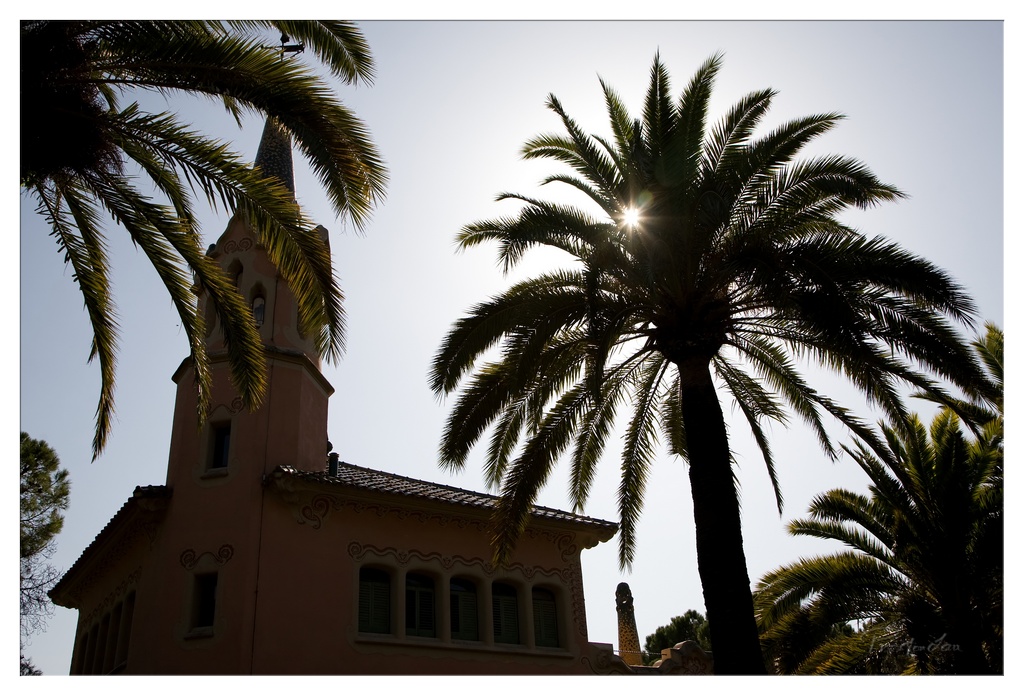

Palm Tree Sentinel Guarding the Gaudi-esque Tower
Rating: 8/10
This image transports us to a sunny locale where a charming pink building, complete with a distinctive tower and decorative facade elements reminiscent of architectural masters, plays hide-and-seek behind the dramatic fronds of several large palm trees. The sun, positioned directly behind the central palm, unleashes a dazzling sunburst effect, turning the sky into a brilliant, near-white expanse and rendering the trees as imposing, dark silhouettes. It’s a classic high-contrast, backlit scenario, creating a sense of tropical warmth and a hint of mystery as the building peeks out from the leafy cover. The mood is bright and sunny, yet the strong shadows lend a dramatic edge, suggesting the power of the midday light.
From a photographic perspective, this shot tackles challenging lighting conditions with mixed success. The composition cleverly uses the palm trees to frame the building and add depth, creating a strong visual anchor with the largest palm dominating the right side of the frame. The low angle emphasizes the height of both the tower and the trees. The backlighting, while creating striking silhouettes and that sought-after sunburst, also leads to a blown-out sky – a common trade-off when exposing for shadowed subjects under bright conditions, though here the building surprisingly retains some decent detail. The limited color palette due to the high contrast simplifies the scene, focusing attention on form and light, making it a bold study in light and shadow, even if the exposure choice feels like a slightly precarious tightrope walk between preserving highlights and lifting shadows.
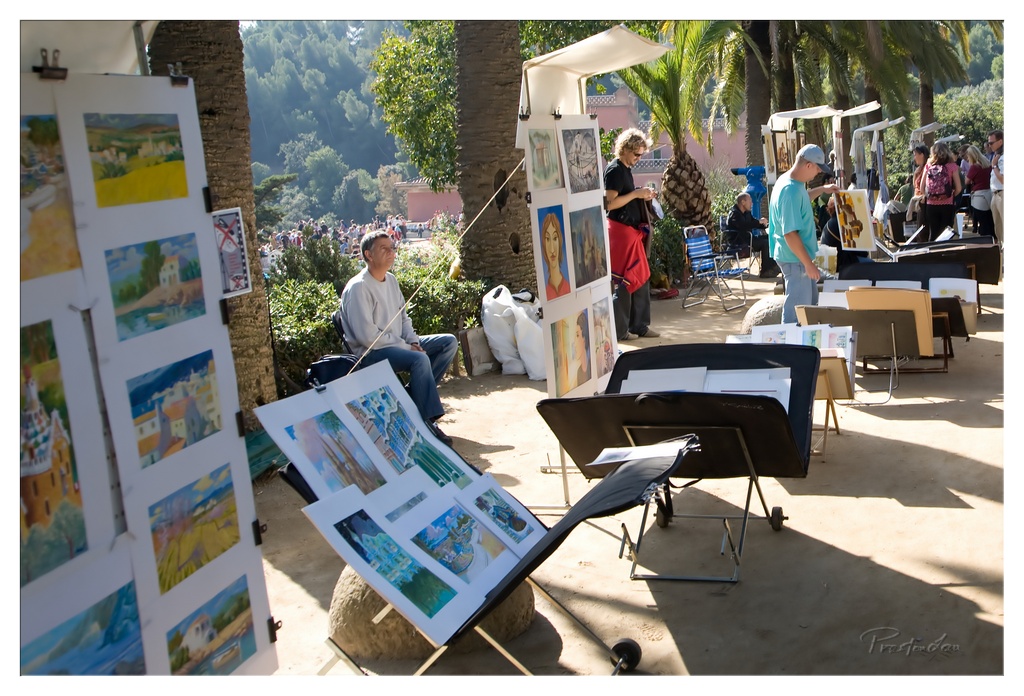

Park Life Palette - 7/10
Capturing the timeless struggle and serene hope of the sidewalk artist, this image presents a bustling park scene where creativity meets commerce. The mood is one of sunny leisure, punctuated by the quiet intensity of artists displaying their wares. In the foreground, a diverse collection of paintings leans or stands on easels and presentation boards, promising glimpses into imagined landscapes and portraits. The composition effectively uses these displays as leading lines and anchors the scene, inviting the viewer to wander through the visual offerings while the strong, directional sunlight casts dramatic shadows, adding texture and depth to the ground plane.
The colors pop, especially the vibrant hues used in the landscape paintings and portraits, standing out against the earthy tones of the park. An artist sits patiently on the left, seemingly lost in thought or observing the potential clientele flowing past in the background crowd, dwarfed by the large palms and distant trees. Further along the pathway, other vendors and curious onlookers add to the lively backdrop. While the subject matter is perhaps familiar, the layering of elements and the capture of the specific moment make for an engaging street scene, showcasing the universal desire to create and share, though the bright sun does create some harsh contrast that tests the dynamic range of the shot.
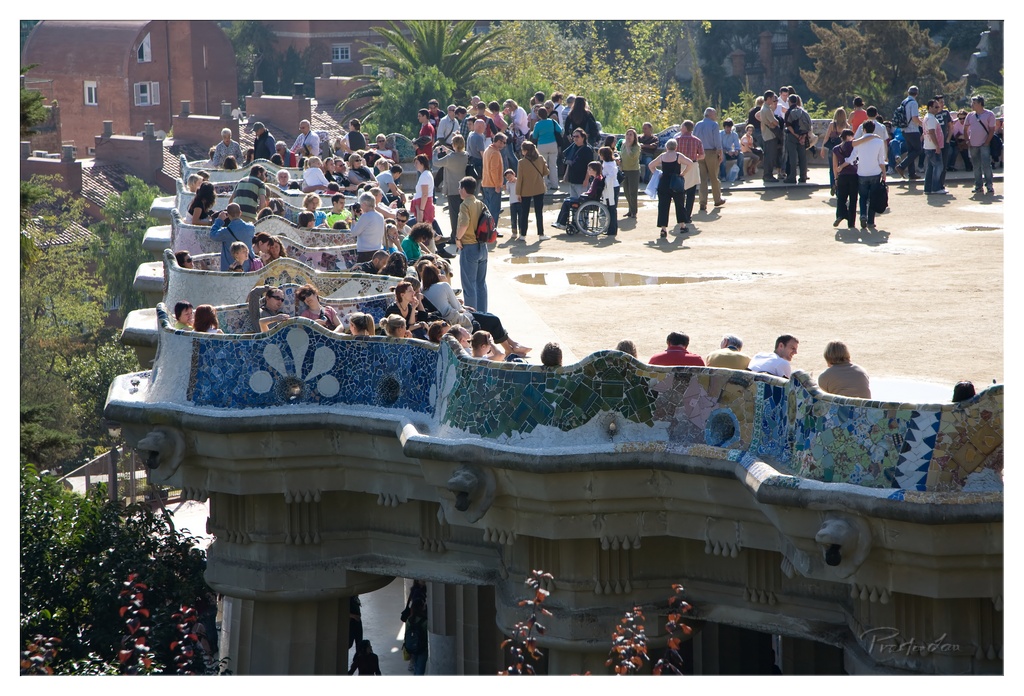

Title: A Seat at the Grand Mosaic Aquarium (aka Park Güell)
Subject Rating: 8/10
This shot perfectly encapsulates the vibrant, if somewhat chaotic, reality of visiting Gaudi's legendary Park Güell in Barcelona. The subject, the iconic serpentine mosaic bench, is a stunning piece of architectural art, but here it plays host to a packed house, giving it the look of a very colourful, very human aquarium exhibit. What's happening is the timeless struggle for prime real estate on a world-famous piece of furniture – people are crammed shoulder-to-shoulder, sitting, standing, chatting, and probably wondering if their backside is getting any actual benefit from the ergonomic curve Gaudi intended, or just more intimate knowledge of their neighbor's denim. The mood is undeniably bustling and sunny, the kind of place where relaxation meets the mild panic of hoping your bag isn't pickpocketed while you're mesmerized by the tile work. Pertinent objects include the glorious, glittering mosaic tiles themselves, the sheer mass of humanity, and the supporting structure beneath the bench that gives this elevated perch its vantage point.
From a photographic standpoint, the elevated composition gives a great sense of scale, allowing the eye to follow the hypnotic curve of the bench like a vibrant river of people. The sunny lighting is typical Mediterranean, providing crisp shadows on the dusty plaza behind but also creating potential contrast challenges – managing exposure on bright days like this is always a balancing act, and the photographer has done a decent job of holding detail across the scene, from the colourful tiles to the figures in the background. The colour palette is a feast, dominated by the rich blues, greens, and whites of the mosaic, punctuated by the earthy tones of the park floor and the warm reds of the distant buildings in the background scene. While capturing such a popular spot inevitably means including the crowds, the sheer density here could be critiqued; it's great for showing the park's popularity, but less so for highlighting the individual beauty of the bench itself. Still, it's an authentic snapshot of a famous place on a busy day, proving that even architectural masterpieces become just another place to sit (if you're lucky) when the tourists arrive en masse.
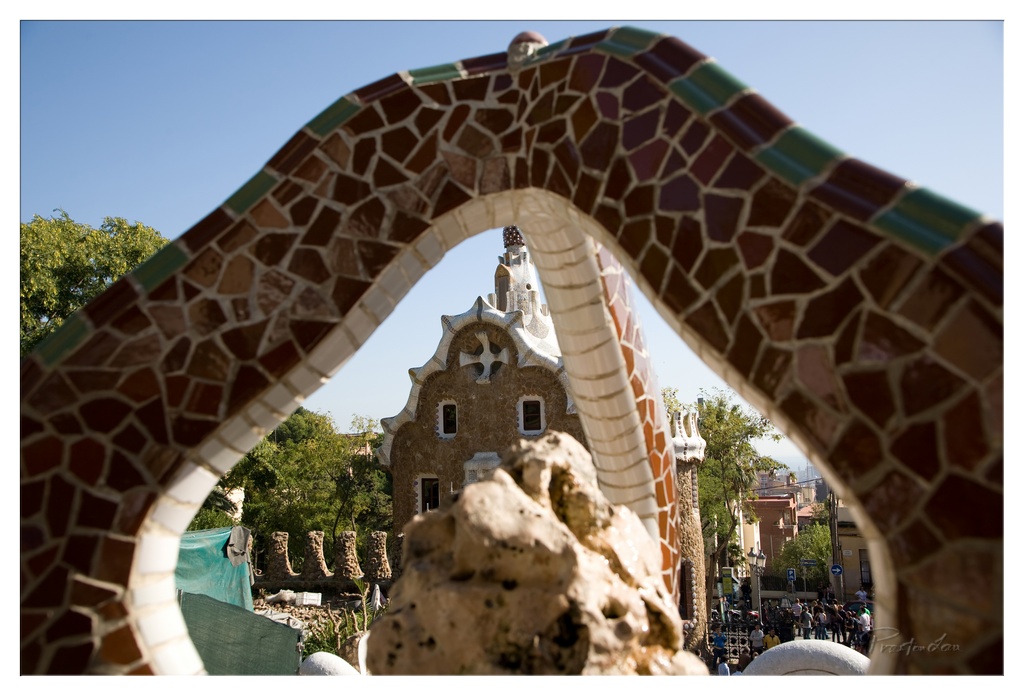

Gaudí's Mosaic Portal to Wonder
Rating: 7/10
Stepping through this vibrant, mosaic-tiled archway feels less like walking in a park and more like entering a portal to a gingerbread village, albeit one designed by a genius architect with a penchant for broken ceramics. The mood is undeniably sunny and whimsical, perfectly reflecting the playful nature of Gaudí's work and the clear blue sky above. What's unfolding is a typical day at a world-famous landmark: visitors meandering, admiring the unique structures, and perhaps questioning the structural integrity of a wall that looks like oversized rock candy. The arch in the foreground acts as a fantastic natural frame, pulling your eye towards the charming, almost cartoonish building centered within its curve, creating a sense of looking *through* the art to appreciate another piece.
From a photographer's perspective, the framing is a strong compositional choice, although the out-of-focus arch dominating the foreground is a bold move. The lighting is bright and consistent, perfect for showcasing the rich, warm colors of the mosaic and the distinct texture of the stone building. However, the prominent, blurry rock in the immediate foreground is a bit of a puzzle; it adds foreground interest but also feels slightly distracting and seems to want to be a main subject itself. It almost feels like an accidental photobomb by a lumpy boulder. Despite this minor quibble, the shot successfully encapsulates the unique atmosphere of the place, capturing the fantastical architecture and the lively buzz of the background scene with its milling crowds and distant cityscape peeking through the trees.
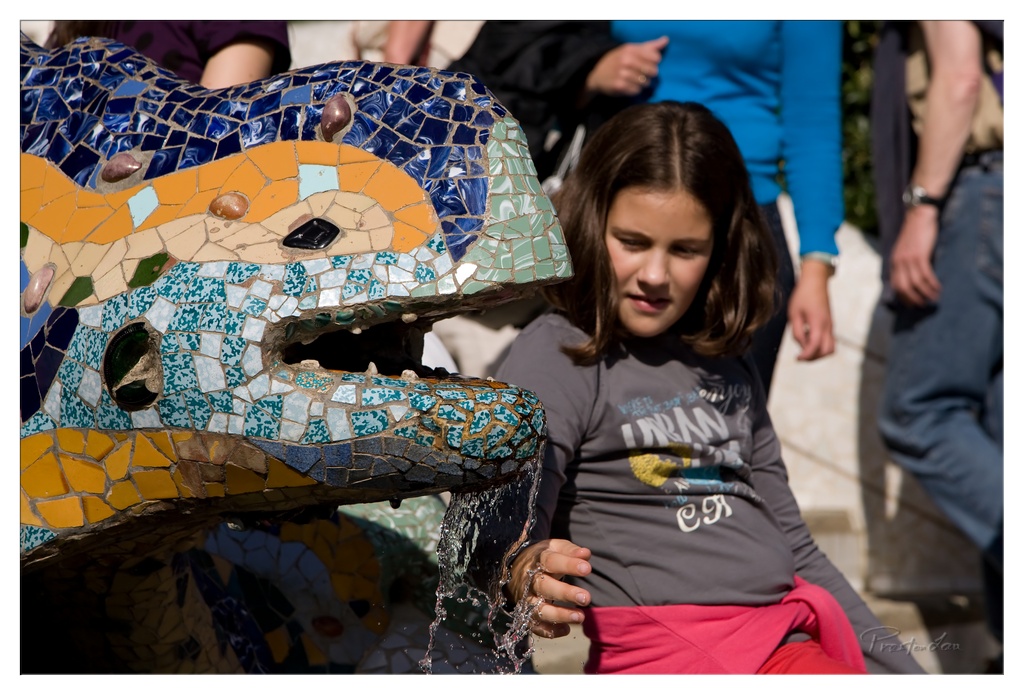

Gaudí's Playmate
Rating: 7/10
This snapshot perfectly encapsulates the vibrant, bustling energy of Park Güell, featuring the iconic mosaic dragon (affectionately known as El Drac) as its star, earning a solid 9/10 for subject matter alone. Here, a young girl, bathed in bright sunlight, reaches out playfully to catch the water splashing from the dragon's mouth, adding a dynamic, human element to the static architectural masterpiece. The mood is undeniably cheerful and lively, capturing a simple moment of delight amidst the famous tourist attraction. The colourful, fragmented trencadís mosaic of the dragon dominates the left side of the frame with its blues, greens, yellows, and oranges, contrasting with the girl's grey shirt and striking pink pants. The background is a softly blurred wash of color and form, suggesting the presence of other visitors enjoying the park.
From a photographic standpoint, the composition feels a bit tight, perhaps a rushed capture of a fleeting moment, with the dragon's tail and parts of the girl's body cut off. The lighting, characteristic of harsh daylight, makes the colors pop, especially on the mosaic, but also introduces high contrast and potential blown highlights on the water. However, the photographer successfully used a shallow depth of field to isolate the main subjects, rendering the background tourists into mercifully anonymous blurs, which is often a blessing in such popular spots. The focus is sharp where it matters – on the dragon's head and the girl's hand reaching for the water, beautifully freezing the motion of the splash. While not a perfect, meticulously composed fine art piece, it's an effective and charming capture of a candid moment that highlights the playful interaction between people and Gaudí's whimsical creation.
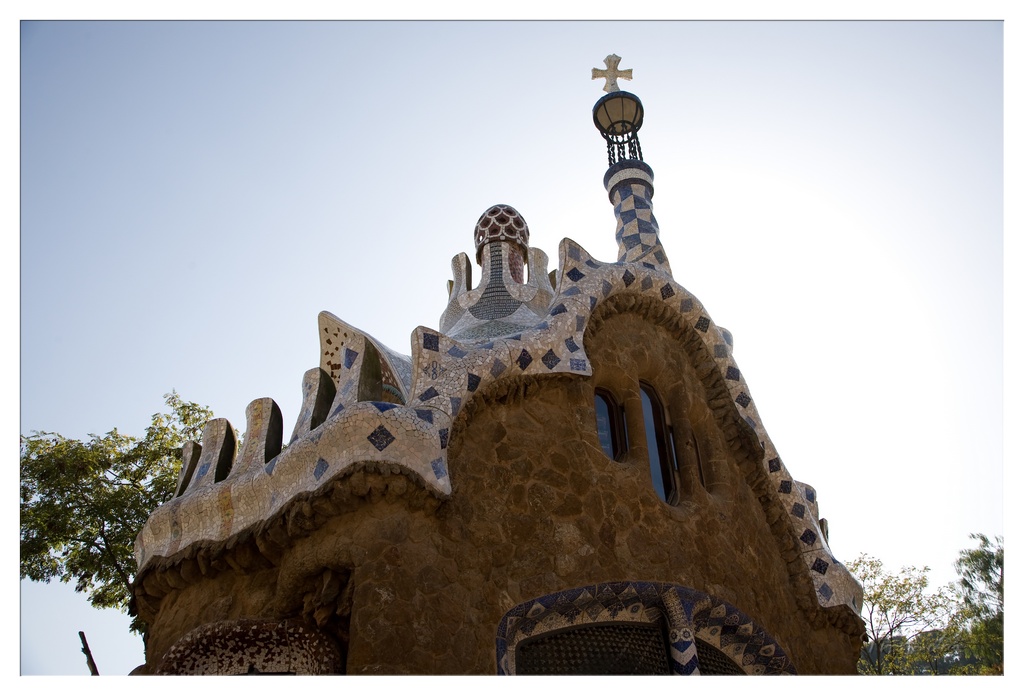

Gaudí's Gingerbread House Gets a Close-Up
Subject: 9/10
Behold, a close encounter with one of Antoni Gaudí's famously fantastical gatehouses, likely from Park Güell in Barcelona. This isn't your average roofline; it's a riot of trencadís mosaic, swirling organic shapes, and architectural whimsy. Nothing much is "happening" here except the building confidently flaunting its utterly unique style against a bright sky. The mood is wonderfully quirky and sunny, transporting you straight into a fairytale dreamscape. You can almost smell the gingerbread, though it's probably just very old stone and pigeon droppings. The standout elements are the mushroom-shaped chimney, the tower topped with a slightly-too-small cross, and the glorious, colorful chaos of the mosaic tiles cladding the roof and architectural flourishes. It’s the kind of subject that practically poses itself, a solid 9/10 on the 'Wow, that's weird and cool' scale.
From a photography perspective, this shot goes for a bold, low-angle composition, letting the architectural madness dominate the frame while pointing dramatically towards the heavens (and the slightly blown-out sky). It emphasizes the building's height and sculptural form, but does leave you wondering if the photographer had to lie on the ground. The lighting is classic midday Mediterranean sun – great for highlighting the textures and vibrant mosaic colors, but tough on the sky, which is practically screaming "I'm too bright!" A bit of fill light or shooting at a less harsh time might have saved those highlights, but hey, sometimes you gotta embrace the light and just make the building pop. The detail captured in the mosaic is fantastic, letting you appreciate every chipped tile. The trees peeking in on the sides offer a touch of nature, but this image is all about that wonderfully eccentric building. It's a clear, focused shot that captures the essence of Gaudí's playful genius, even if the sky looks like it needs a nap.
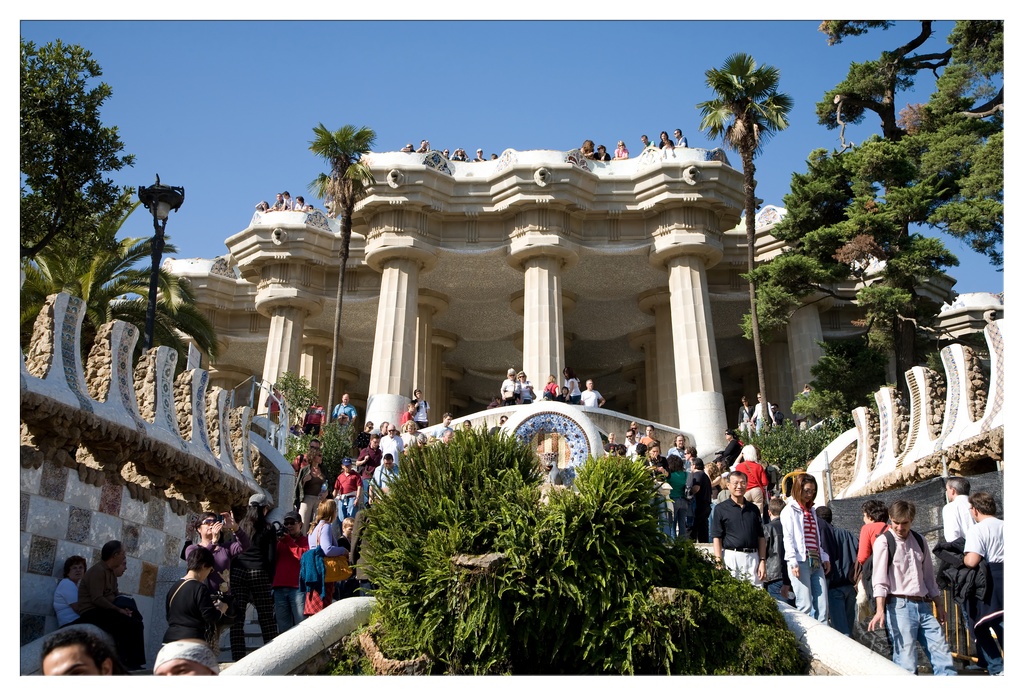

Gaudí's Grand Entrance, Plus People!
Rating: 7/10
Welcome to the bustling entrance of Park Güell, where Antoni Gaudí's architectural marvels meet the modern-day pilgrimage of tourists! This image perfectly captures the scene at the Hypostyle Room, showcasing the impressive, almost temple-like colonnade supporting the famous serpentine bench above. What's happening? Well, mostly people... lots and lots of people, all seemingly engaged in the universal tourist activity of "looking around while standing in a crowd." The mood is decidedly lively, if not a touch overwhelming, under a bright Catalan sun. Despite the human element, the grandeur of Gaudí's design shines through, earning the location itself a solid 7/10 for sheer architectural brilliance, though getting a clean shot without a photobomber seems to be the day's main challenge.
From a photography perspective, this shot tackles the age-old challenge of capturing iconic architecture amidst throngs of visitors. The composition uses the decorative, curved wall on the left as a visual guide, leading the eye up towards the impressive columns. However, the sheer volume of people scattering throughout the frame makes for a busy scene that lacks a clear, dominant focal point beyond the general structure. The bright, sunny lighting is a double-edged sword; it brings out the textures and colors of the stone and mosaics beautifully, but also creates harsh shadows, particularly on faces, which can flatten the image or obscure details. The photographer did well to frame the structure between the lush green foliage, adding depth and context, but wrestling with the exposure in such contrasty light is always a battle. It's a classic tourist shot: great subject, tricky conditions, and the unavoidable reality of sharing a masterpiece with everyone else who had the same brilliant idea to visit today.
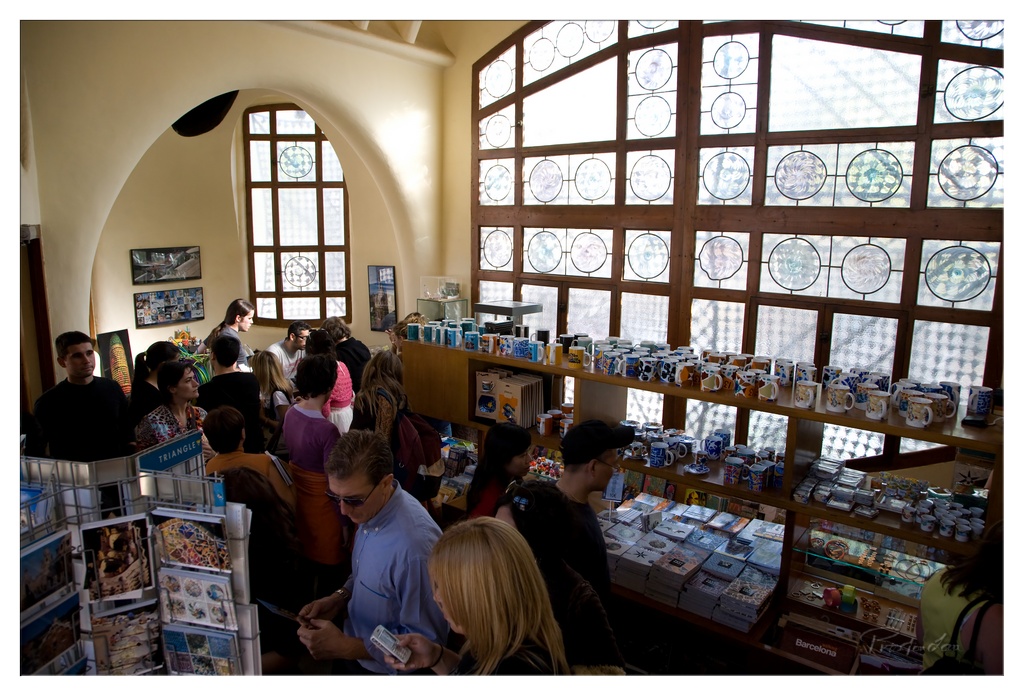

Architectural Souvenirs
Rating: Subject: 7/10
Step right up and prepare your credit cards, folks, because we've landed in a gift shop that clearly believes in the "more is more" philosophy when it comes to merchandise! This bustling scene captures the timeless dance of tourism and commerce, set against a backdrop of stunning architecture. On the left, elegant arches hint at the building's grandeur, while on the right, a wall of large, multi-paned windows, some featuring beautiful circular designs, floods the space with light. People are dotted throughout, some intently examining colorful mugs, others perhaps debating the literary merit of various guidebooks or simply trying not to bump into each other. The atmosphere is lively and bright, radiating the slightly harried energy of a popular tourist spot where everyone is on a mission to find that perfect, dust-collecting souvenir. It's a snapshot of a moment in the retail lifecycle, where hopes are high and wallets are about to get significantly lighter.
From a photographic perspective, the composition here uses the strong geometric lines and curves of the architecture to frame the busy human activity below. The elevated viewpoint provides a good overview of the shop's layout and the sheer volume of items on display, though the foreground display does feel a little close. The lighting, courtesy of those magnificent windows, is the undoubted star, creating a high-contrast, bright scene that perfectly encapsulates the feeling of a sunlit interior. However, this bright light does lead to some blown-out highlights in the windows, which is a common challenge in such conditions. The color palette is rich, contrasting the warm wood and walls with the vibrant hues of the various products. The overall style is that of a candid observation, capturing the scene as it unfolded, favoring atmosphere and action over technical perfection. It effectively conveys the sense of a busy, vibrant, and visually interesting space, even if it doesn't win any awards for delicate shadow work.
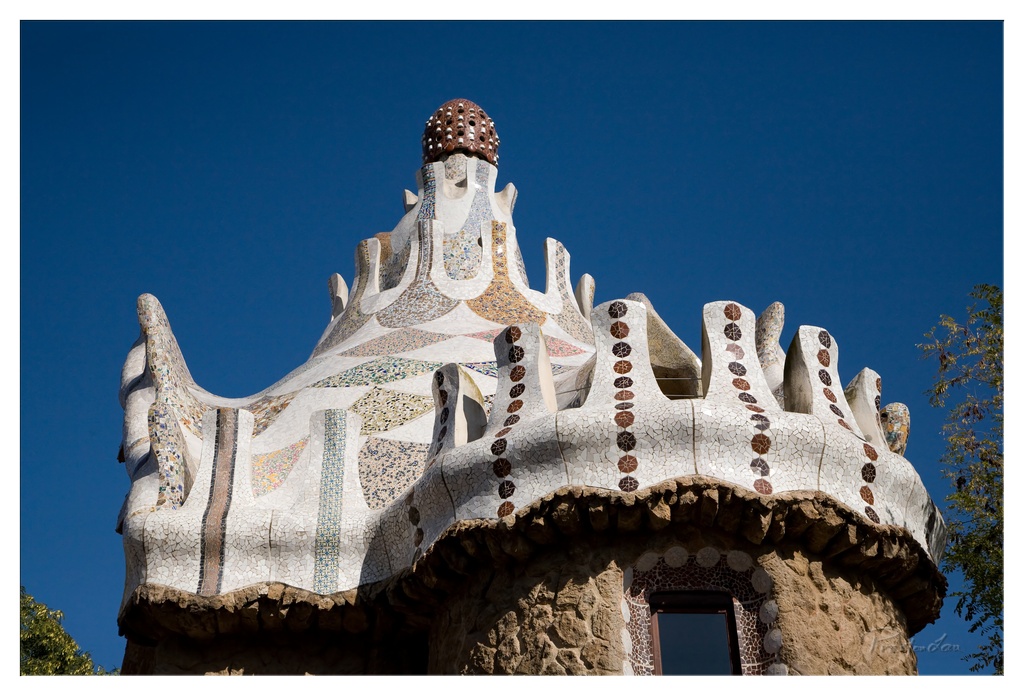

Whimsical Architectural Crown
Rating: 9/10
This image captures the fantastic upper section of a building, a true riot of organic forms and vibrant mosaic work, which honestly looks like a giant, fantastical meringue dreamed up by a whimsical architect. The subject, this incredibly detailed and uniquely shaped roof, is easily a 9 for its sheer visual interest and the craftsmanship it represents. What's 'happening' is the building itself putting on a show against a stark blue sky; its undulating surfaces and spikey protuberances demand attention. The mood is one of bright, sunny wonder, a feast for the eyes that feels both playful and substantial. The building's crown, topped with a textured, spiky finial, is covered in countless tiny ceramic tiles (trencadís), forming intricate patterns and waves of colour across its complex shape. The base visible below transitions to rougher stone, hinting at the structure supporting this elaborate spectacle.
From a photographic perspective, the composition is smart, tilting up to isolate this most captivating part of the building against the clean backdrop of the sky. This low angle emphasizes the height and the dramatic contours of the roof. The lighting is strong and directional, casting defined shadows that sculpt the complex surfaces and highlight the texture of both the mosaic and the stone base. The colours pop beautifully against the deep blue sky – the whites and muted tones of the mosaics are accented by bolder patterns and colours, creating a rich tapestry. The subject matter is pure architectural artistry, capturing the essence of a style that eschews straight lines for fluid, naturalistic shapes. The tree branch creeping in on the right adds a touch of natural context, a subtle reminder that this fantastical creation exists within the real world, though it might make you question if you've stepped into a fairy tale. Capturing this level of detail under bright sunlight requires careful exposure, and here it seems well-managed, preserving detail in both the highlights and shadows of the textured surfaces.
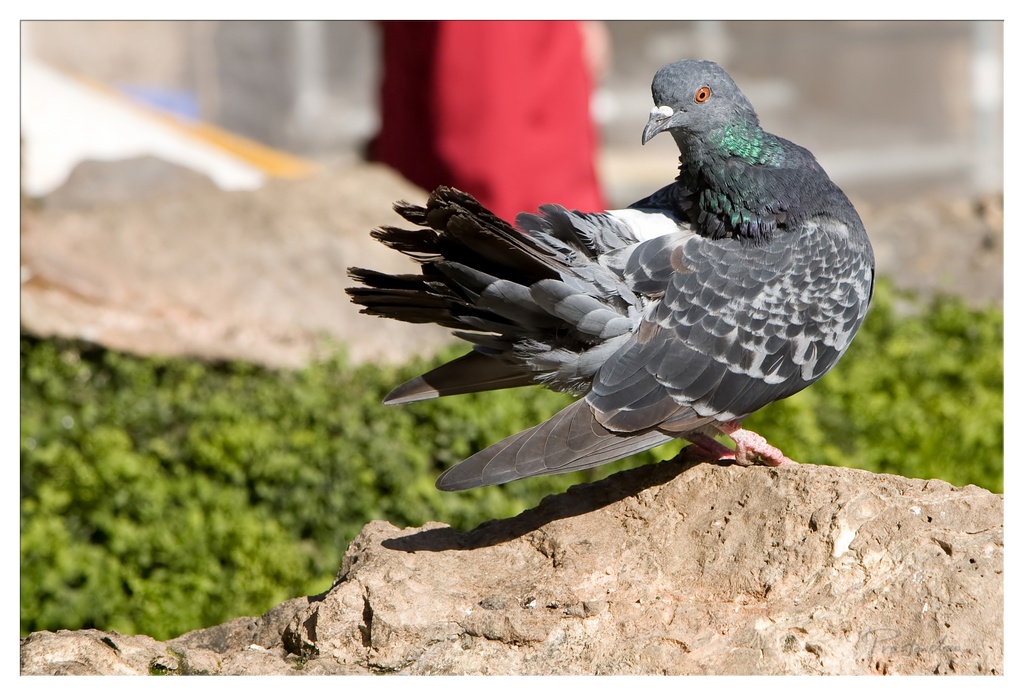

The Tail Fan
Subject Rating: 7/10
Behold, the humble city pigeon, elevated to rock star status (literally, he's on a rock) in this portrait. Our feathered friend is caught in the act of what appears to be a casual tail fan or a preening session, giving us a lovely view of his layered plumage. The mood is relaxed, almost contemplative, despite the bird's everyday presence. It's a straightforward subject matter – a common bird – but presented with a certain dignity that makes you look twice. This isn't just some dumpster diver; this is *the* pigeon, perhaps auditioning for America's Next Top Bird Model.
From a photographic perspective, the composition places the pigeon nicely off-center, allowing the fanned tail feathers to lead the eye into the frame. The lighting is quite bright, catching the iridescent greens on the neck and highlighting the texture of the feathers and the rock, although it creates some strong shadows. The color palette is natural and pleasing, with the cool grays and whites of the bird contrasting with the warm tones of the rock and the soft green blur of the background. The background is a beautifully rendered bokeh, featuring soft greens and glimpses of a blurry reddish shape and lighter tones beyond, effectively isolating the sharp subject and adding depth. It's a classic wildlife portrait style, proving you don't need an exotic subject to make a compelling image if you capture it well. The pertinent objects are simply the pigeon and its rocky perch amidst the greenery.
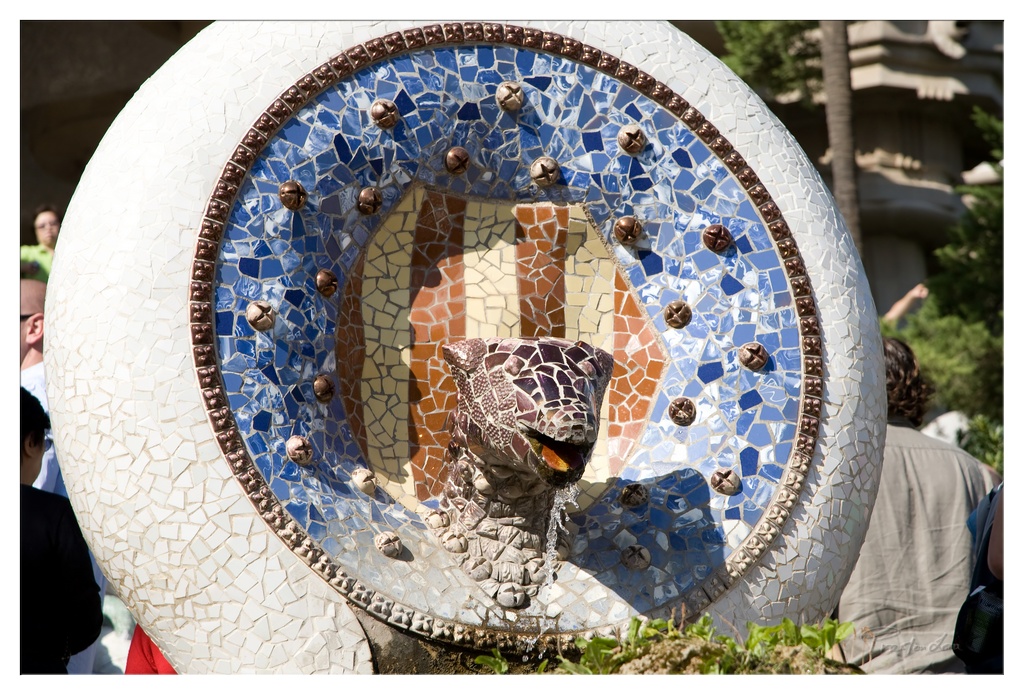

Gaudí's Spitting Image
Subject Rating: 9/10
This image captures a close-up of a vibrant mosaic sculpture of a lizard or salamander's head, characteristic of Antoni Gaudí's work, likely found within Park Güell in Barcelona. The intricately tiled creature is serving its public duty as a fountain, with a stream of water cascading from its open mouth, creating a delightful, whimsical focal point. The head itself is a masterpiece of the trencadís mosaic technique, composed of countless irregular ceramic fragments in rich purples and browns, giving it a scaly texture. It sits within a much larger, circular mosaic structure adorned with striking blue and white patterns interspersed with intriguing metallic fasteners, all framed by a broad band of white mosaic tiling. The overall mood is cheerful and artistic, bursting with color under the bright sun.
From a photographic standpoint, the composition is centered around the fascinating mosaic creature and its surrounding artistic halo, drawing the viewer into the intricate details of Gaudí's design. The bright, direct sunlight, while perhaps a nightmare for soft portraiture, works effectively here to highlight the texture and reflective quality of the mosaic tiles, creating strong contrasts and defined shadows that emphasize the depth of the relief sculpture. However, the harsh light also leads to some blown-out highlights on the white tiles. The background, blurred by a relatively shallow depth of field, hints at the bustling public nature of the location with glimpses of people, trees, and park architecture, providing context but also suggesting the common challenge of getting a clean shot in a popular tourist spot. The inclusion of the peculiar screws integrated into the blue mosaic pattern adds an unexpected, almost industrial detail that juxtaposes humorously with the organic form of the spitting creature, making you wonder if the lizard is securely fastened or merely accessorizing.
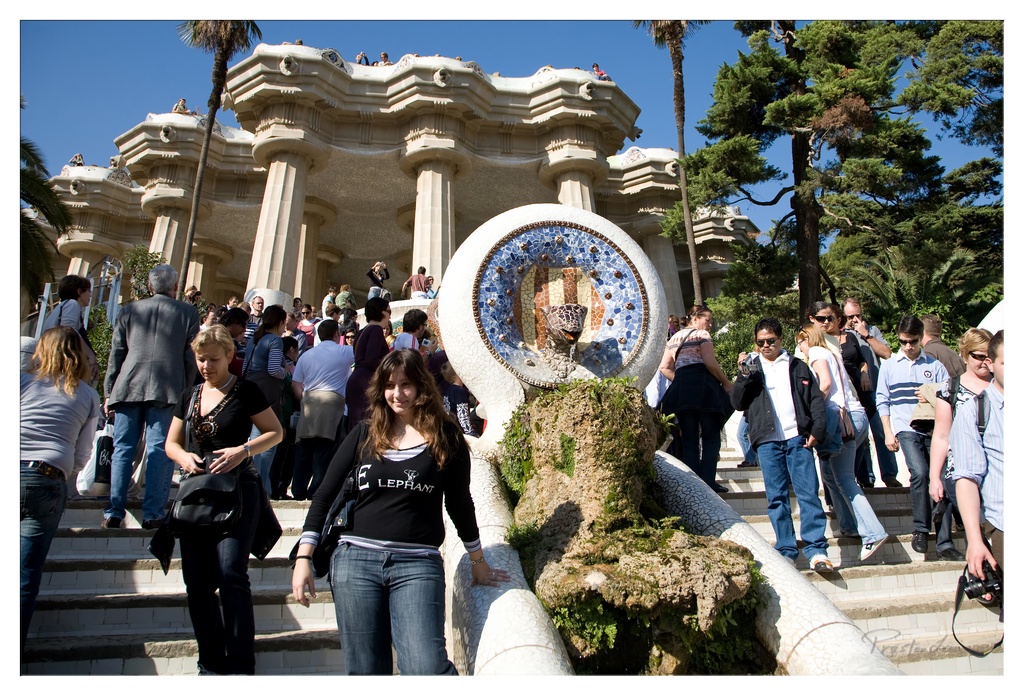

Title: The Great Gaudi Lizard Photobomb of '07 (or whenever it was)
Rating: 7/10
Ah, Park Güell! A truly magnificent Gaudi masterpiece, here captured in its natural state: absolutely drowning in tourists. The magnificent mosaic lizard (a solid 8/10 subject on its own, honestly, he's got personality) attempts to hold court at the bottom of the grand staircase, but he's utterly surrounded by a sea of fellow travelers. This shot perfectly encapsulates the charming chaos of visiting a world-famous landmark on a sunny day, where finding a clear line of sight without a stranger's elbow in frame is about as likely as finding a quiet cafe nearby. The composition uses the iconic stairs as a strong diagonal leading upwards, and the central positioning of the ceramic dragon gives the eye a focal point, but the sheer volume of humanity acts as a kind of visual white noise, turning the scene into a vibrant, if slightly overwhelming, mosaic of people.
The lighting is classic bright Spanish sun – fantastic for making the blues and greens of the mosaics pop, but less forgiving on the human faces, which seem to be collectively battling the glare. The background architecture, with its undulating colonnade and intricate ceiling, provides a stunning backdrop, unfortunately partially obscured by a continuous flow of backpack-wearing enthusiasts and folks just trying to get up the stairs without tripping. Note the determined look on the woman in the black "Elephant" shirt in the foreground – she's navigating the crowd like a seasoned explorer, probably wondering if she left the iron on. While perhaps not a masterclass in isolation or serene landscape photography, this image is a dynamic snapshot of a beloved place teeming with life and highlights the challenges (and reality) of capturing iconic spots in peak tourist season.
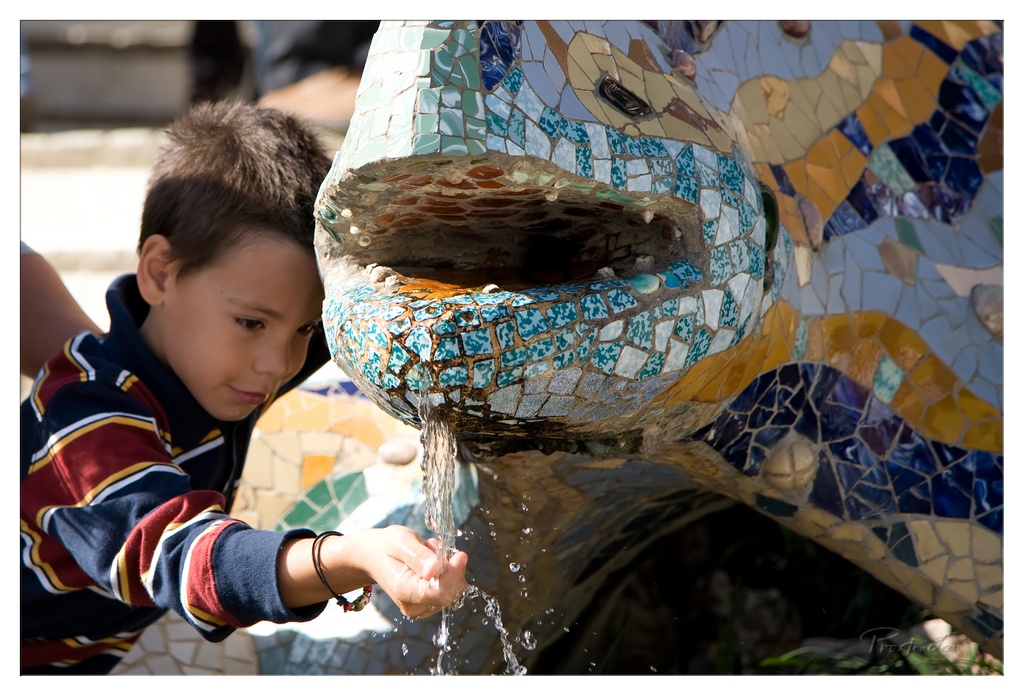

Dragon Drink
Subject Rating: 9/10
Ah, the classic tale: boy meets dragon, dragon offers water. A truly heartwarming moment, assuming this particular mosaic lizard isn't prone to spitting fire instead of refreshment. Our subject, a young lad with a very sensible striped shirt, is caught mid-slurp from the iconic tiled maw, proving that even mythical beasts can serve a public function as a rather fancy drinking fountain. The mood is light and playful, capturing that simple childhood joy of interacting with something unique and quirky – like trying to get hydration from a perpetually grinning ceramic reptile. You can almost hear the splashes and perhaps a quiet "thank you" to the scaly benefactor. It's a charming snapshot of a moment that feels both specific to a place and universally relatable to anyone who's ever been thirsty near a public fountain.
From a photography perspective, this image makes good use of a relatively shallow depth of field, isolating the boy and the dragon's head from the slightly blurred background, which appears to be typical park stairs and some foliage – probably not as exciting as the foreground anyway. The composition places the boy on the left, looking towards the dragon's powerful form on the right, creating a dynamic interaction across the frame. Lighting is standard bright daylight, which gives the vibrant mosaics their punch and makes the water glint, but also creates some fairly strong shadows, particularly under the dragon's snout. The colors are a riot of blues, greens, yellows, and browns from the tiles, perfectly contrasted by the bold primary colors on the boy's top. It's a candid shot, capturing a fleeting moment effectively, demonstrating that sometimes, the best subjects are simply a kid and a cool, albeit inanimate, friend.
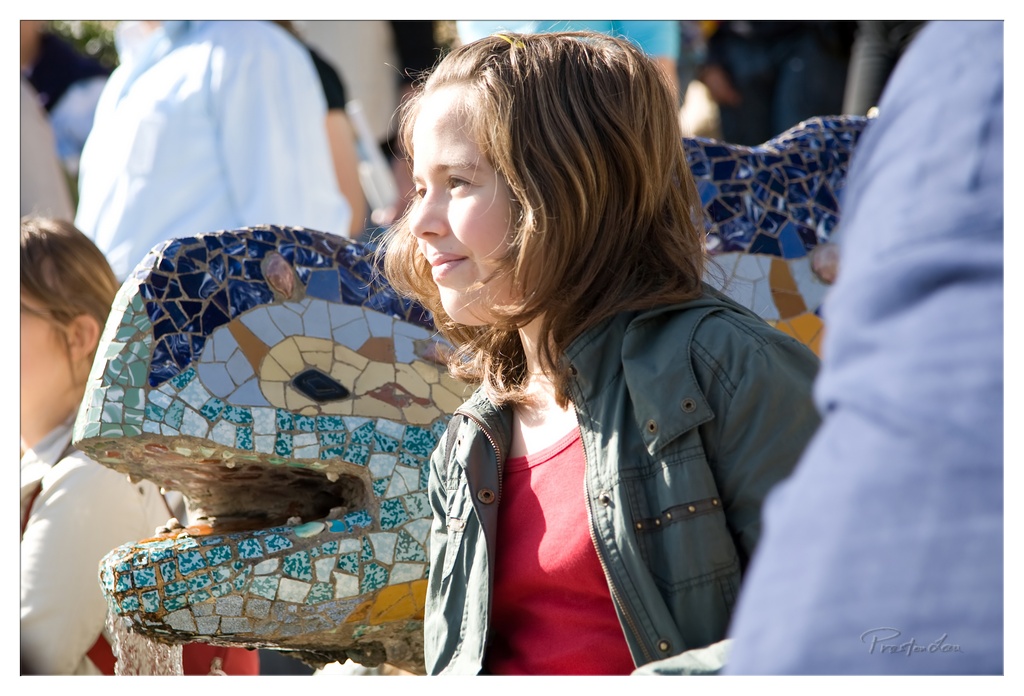

Sunny Smile with a Mosaic Dragon Friend
Subject Rating: 8/10
Here we have a lovely shot of a young girl, perhaps enjoying a sunny day in a park. She's looking off to her left with a slight, pleasant smile, her face gently illuminated by the sun. She's wearing a practical green jacket over a bright red top, adding a pop of color that complements the vibrant surroundings. She appears to be seated next to a truly magnificent object – a section of a large, colorful mosaic structure that strongly resembles the head of a dragon or lizard, pieced together with intricate, broken ceramic tiles in blues, greens, yellows, and whites. The mood is undoubtedly relaxed and happy, capturing a simple moment of enjoyment in a picturesque location.
From a photographic perspective, the composition places the girl nicely on the right side of the frame, her gaze leading the viewer into the left space, creating dynamic flow. However, one might argue the real star is the stunning mosaic, which dominates the left and center foreground with its incredible detail and texture. The shallow depth of field effectively blurs the background, isolating the girl and the mosaic feature from the surrounding crowd of people, including a prominent light blue shirt on the left and another figure on the right, keeping the focus firmly on the main subjects. The lighting is bright and sunny, which is great for mood and color saturation, especially on the mosaic, although it does create some noticeable highlights on the girl's cheek and forehead – a classic sunny day challenge! The vibrant colors of the mosaic contrast beautifully with the more muted tones of the girl's outfit and the background, making the art truly pop. This feels like a candid portrait captured during a moment of peace amidst the likely hustle and bustle of a popular tourist spot (hello, Park Güell vibes?).
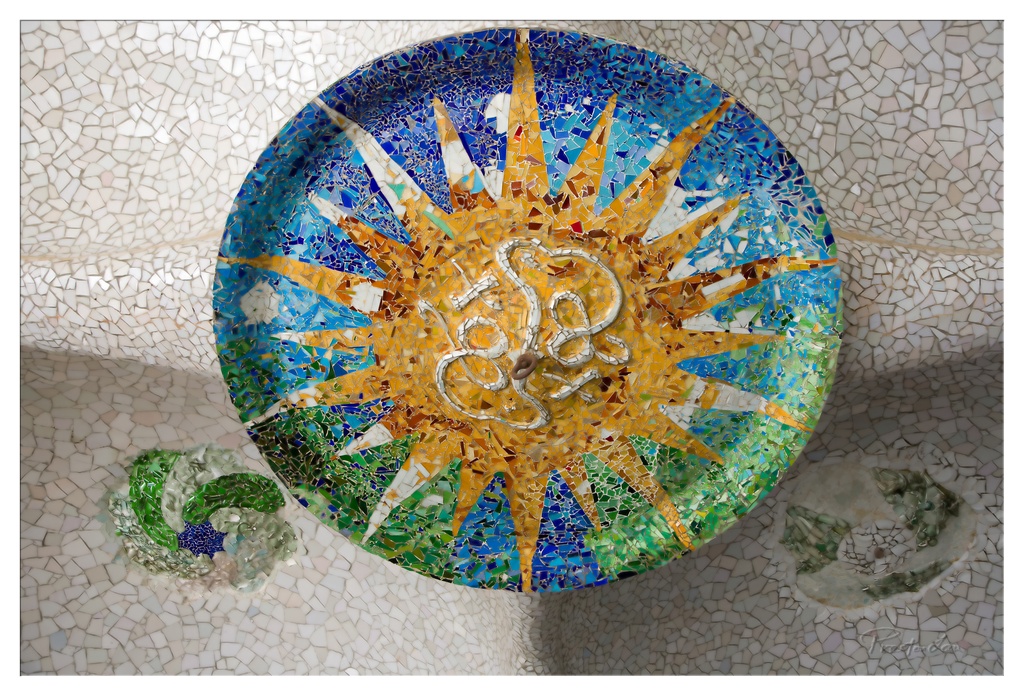

Mosaic Sun Serpent
Subject Rating: 9/10
Here we have a magnificent example of Catalan Modernism, likely from the whimsical mind of Antoni Gaudí, rated a solid 9 out of 10 for its sheer artistic brilliance and intricate detail. The image captures a vibrant, circular mosaic depicting a blazing sun with sharp, angular rays radiating outwards in shades of yellow, orange, and gold, surrounded by rings of cool blues and greens. At the heart of the sun is a raised, pale, serpentine or spiral motif – perhaps a stylized serpent, a symbol of eternity, or maybe just Gaudí having a bit of fun with ceramic worms. This is a static, detailed portrait of a grand architectural element, inviting viewers to get lost in the thousands of tiny, broken ceramic pieces that make up its form. The mood is certainly artistic and energetic, capturing the spirit of a sunny, creative locale.
From a photography perspective, this shot does a commendable job of capturing the complex textures and varied colors of the trencadís mosaic technique. The composition places the primary sun motif front and center, which is logical given its visual dominance, though a slight shift might have better integrated the two smaller, equally intriguing green and white mosaic shapes below. The lighting appears to be soft, possibly diffused daylight, which is ideal for minimizing harsh reflections off the glazed ceramic pieces and bringing out the subtle variations in depth and color. The background, a sea of seemingly random white mosaic shards, provides a crucial textural contrast and emphasizes the deliberate artistry of the main subject. Capturing such a busy scene while maintaining focus and detail on the central element is tricky; getting the entire depth of the relief sharp requires careful focusing or a favorable aperture. The signature in the bottom right corner adds a personal touch, rooting the artwork to its creator, or perhaps just the photographer who documented this dazzling, tile-tastic spectacle. Getting dizzy yet?
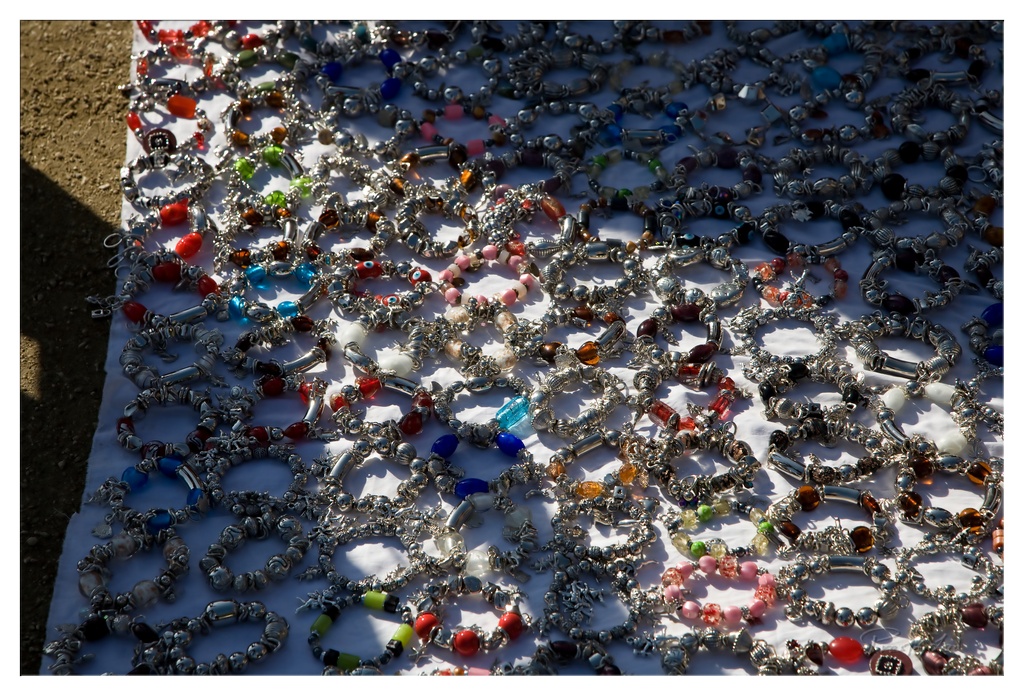

Bracelet Bonanza
Rating: 7/10
Welcome to a magpie's fever dream, captured in glorious, sun-drenched detail! This image presents an absolute avalanche of bracelets, laid out on a white surface like a sparkling, serpentine carpet. It's a dizzying display of metallic links, colorful beads, and assorted charms – hearts, animals, generic shiny bits – all jumbled together in chaotic abundance. You can practically feel the urge to rummage through the pile, searching for a hidden gem (or just getting tangled in the process). The sheer quantity is the story here, suggesting a bustling market stall or perhaps the aftermath of a jewelry box explosion.
From a photographic perspective, this shot leans into the 'more is more' philosophy. The composition is a high-angle plunge into the bling, filling the frame edge-to-edge, save for a sliver of the dusty ground on the left. The lighting is classic harsh midday sun, which does wonders for making the metal *sparkle* – almost to the point of retina-searing intensity – but also creates some deep, contrasty shadows. While the density effectively communicates the sheer volume of bracelets, it makes isolating any single piece difficult; it's a tapestry of texture and color rather than a showcase of individual items. The palette is a cheerful mix of silver tones punctuated by pops of red, blue, pink, green, and earthy beads, all popping against the simple white backdrop. It's a style that screams 'local market find' – vibrant, slightly messy, and full of potential treasures.
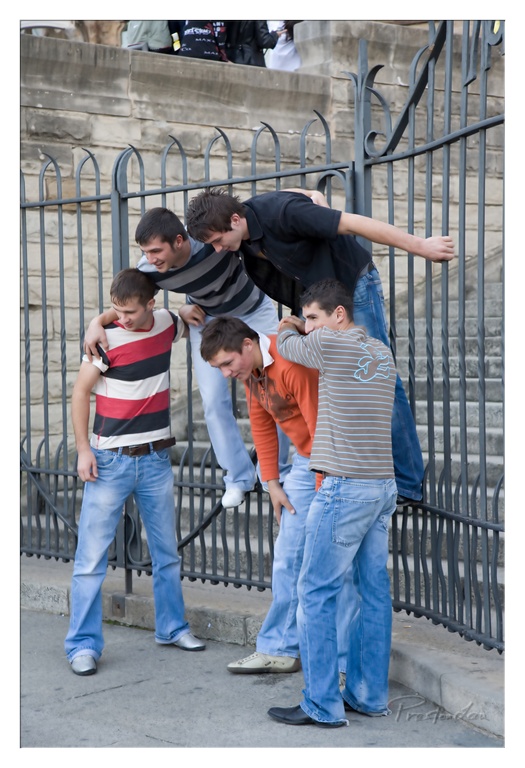

The Fence Posers
Subject Rating: 6/10
Okay, gather 'round, lads! We've got a classic "hanging out near a fence" scenario here. The subject matter features five young men congregating around a rather sturdy-looking metal fence. It appears they're in mid-pose, possibly attempting some sort of impromptu parkour demonstration or simply deciding who gets to climb over first. The vibe is distinctly casual, perhaps a tad awkward, like a band trying to look cool for their first album cover before they've actually written any songs. You can almost hear someone saying, "Alright everyone, act natural! But also... lean on the fence dramatically." Relevant objects include the prominent black metal fence with its decorative flourishes, a grey stone wall and steps in the background, and a variety of casual jeans, t-shirts, and sweaters on the young men. The background is unassuming, typical of an urban or public space, lending a somewhat raw, unpolished feel to the scene.
From a photography perspective, the composition is dominated by the strong vertical lines of the fence, which unfortunately act as a bit of a visual barrier between the viewer and the subjects. While the fence adds texture and depth, placing the figures both in front of and behind it creates a somewhat cluttered scene. The lighting is quite harsh, likely direct daylight, resulting in strong contrasts, blown-out highlights (look at their faces!), and deep shadows. This kind of light can be unforgiving, flattening features and washing out color detail. The color palette is dominated by blues, greys, and neutral tones, punctuated by a few brighter clothing items like the striped and orange tops. The style feels like a captured moment, perhaps slightly staged, leaning towards documentary but without a strong narrative. It's a good example of the challenge of shooting multiple people with varying interactions and positions in less-than-ideal lighting conditions; getting everyone looking halfway decent and engaged is a feat in itself, even if the overall composition is a bit chaotic.
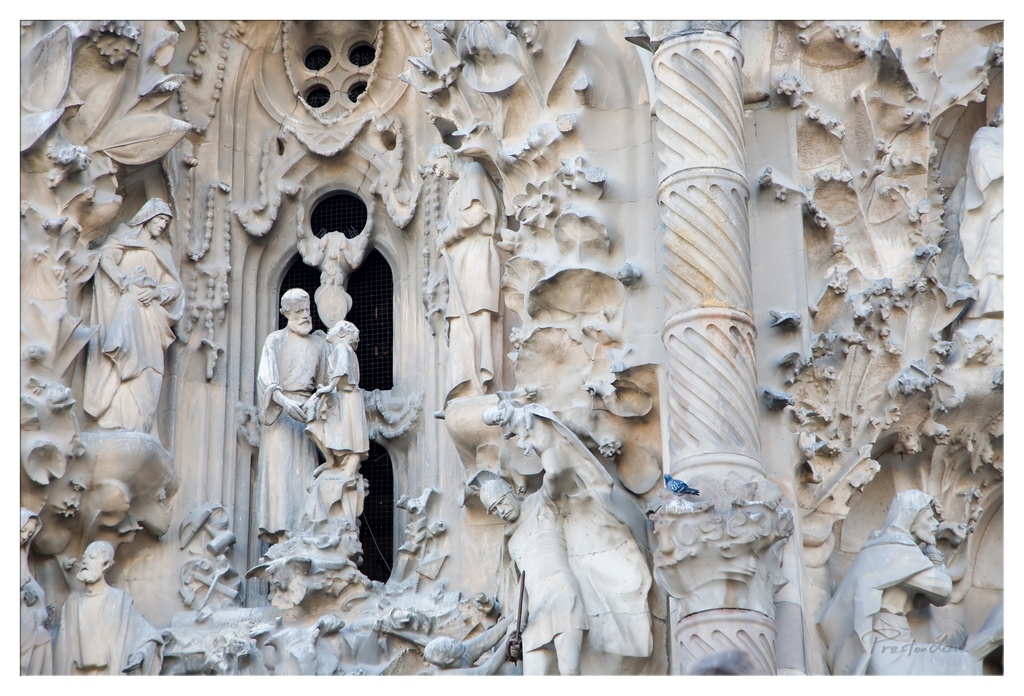

Stone Stories and a Feathered Critic
Subject Rating: 9/10
This photograph plunges us into the extraordinarily intricate world of a carved stone facade (Subject Rating: 9/10), a subject so dense with detail it makes you wonder if the sculptor ever slept. What's happening here is a visual symphony of religious or historical narrative frozen in time, complete with robed figures, dynamic poses, and exuberant organic decoration that seems to sprout from the stone itself. Adding a touch of unexpected vitality, a single pigeon has taken up residence on a prominent, spiraling column, perhaps contemplating the fleeting nature of birdseed versus eternal stone art. The mood is one of overwhelming grandeur and meticulous craftsmanship, slightly leavened by the relatable, slightly cheeky presence of the bird.
From a photographer's standpoint, capturing this level of detail is both a dream and a potential headache. The composition is a tight crop that attempts to make sense of the visual chaos, focusing on a section that showcases the variety of elements from figures to architectural features and decorative motifs. The lighting, likely strong daylight from the side, does a fantastic job of raking across the surface, creating dramatic shadows and highlights that really pop the texture and relief of the carving – though nailing the exposure across such dynamic range requires skill (or maybe just good luck). The limited colour palette focuses the eye purely on form and texture, highlighting the sheer artistry involved. It’s a great study in texture and detail, proving that sometimes, even ancient stone needs a modern, feathery critique.
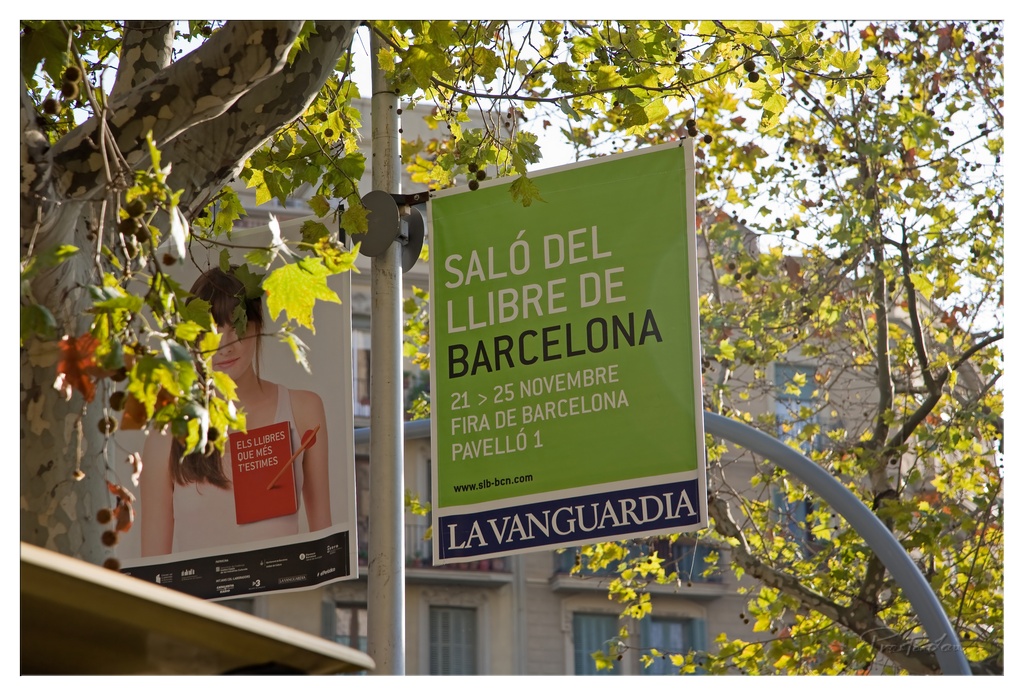

Tree-mendous Advertising Blockage
Subject Rating: 6/10
Ah, the classic "Nature vs. Advertising" showdown, expertly captured with a deciduous participant determined to star in this photo. The primary subjects here are two large banners hanging from a street pole, promoting events in Barcelona. The right banner clearly proclaims the "Saló del Llibre de Barcelona" (Barcelona Book Fair) with its dates (21 > 25 Novembre), location (Fira de Barcelona, Pavelló 1), and sponsor (LA VANGUARDIA), looking relatively crisp despite the leafy assault. The left banner, however, is playing a more mysterious role, partially obscured by the very tree that hosts the photogenic autumn foliage and dangling seed balls. We can make out a woman holding a red book impaled by an arrow (deep!), and some text in Catalan below, but its full message remains tantalizingly hidden behind the vibrant green and brown leaves. The overall mood is a blend of public information and natural chaos, giving a sense of an everyday urban scene where the planned environment meets the unruly beauty of nature.
From a photographic perspective, the composition is dominated by the unapologetically foreground tree, which creates a complex frame of branches and sun-dappled leaves. This artistic choice results in a unique depth, with the banners tucked behind the natural elements, though it does make reading the advertisements a bit of a treasure hunt. The lighting is a mix of bright sunlight hitting the leaves and casting shadows on the banners, creating a dynamic pattern of light and dark areas. The color palette is rich, combining the intense greens of the banners and some leaves with the warmer tones of autumn foliage, tree bark, and the striking red book. The background buildings are pleasingly blurred, thanks to a relatively wide aperture or focus on the foreground/midground, isolating the main subjects and their arboreal gatekeeper. It's a shot that perfectly encapsulates the charming, if slightly frustrating, reality of urban life where nature doesn't always respect promotional efforts.
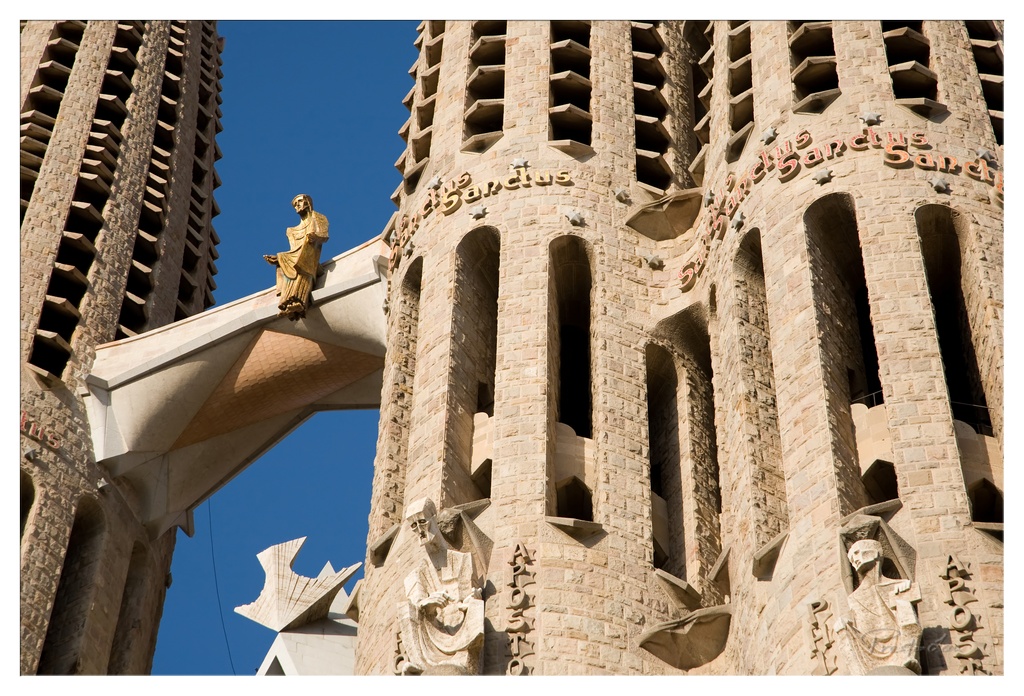

Sagrada Familia Close-Up: Holy Detail
Rating: 9/10
Ah, the Sagrada Familia, Barcelona's perpetually 'almost finished' masterpiece! Here we see a close-up of its intricate facade, focusing on the upper reaches where two towers are linked by a rather precarious-looking bridge. Perched on this architectural high-wire act is a lone statue, looking for all the world like it's waiting for a bus that's never coming, or perhaps just contemplating the sheer audacity of Gaudi's vision (and the construction schedule). The subject matter itself is undeniably iconic and packed with fascinating detail, from the honeycomb-like windows to the carved figures and the text "Sanctus Sanctus Sanctus" wrapping around the tower like a heavenly billboard. Nothing much is 'happening' here in terms of action, but the scene buzzes with the implied history and ongoing construction saga of this unique basilica, creating a mood that is both majestic and slightly surreal.
From a photographic standpoint, this shot delivers on detail. The composition is tight, emphasizing the connection between the towers and drawing the eye to the statue as a central element within the larger architectural context. The vertical lines of the towers are powerful, contrasted nicely by the diagonal thrust of the bridge. Lighting is quite strong, thanks to the bright, clear blue sky, which provides a vibrant backdrop and creates dramatic shadows that accentuate the texture of the stone and the depth of the carvings. While direct sun can sometimes be harsh, here it works well to highlight the intricate stonework. The golden hue of the statue catches the light brilliantly, adding a touch of warmth and visual interest. It's a strong example of architectural detail photography, successfully capturing the spirit and complexity of one small part of this extraordinary building, though perhaps leaving the viewer wanting a wider shot to grasp the true scale.
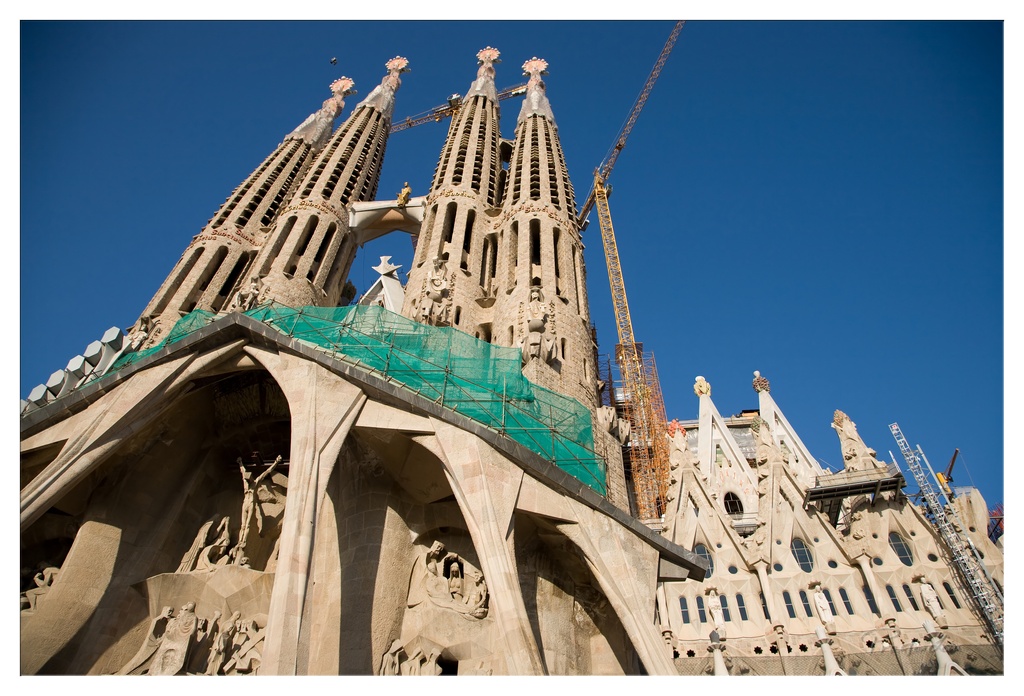

Title: The Never-Ending Symphony of Stone and Steel
Subject Rating: 9/10
Ah, the Sagrada Familia, a subject that demands a high rating simply for existing in such gloriously over-the-top fashion. This shot perfectly captures its essence: a breathtaking architectural marvel perpetually under construction, because apparently Gaudí's vision was less "building" and more "eternal work in progress." The mood here is one of ambitious grandeur mixed with a healthy dose of "Yep, still got scaffolding." Against a brilliant, cloudless blue sky, the ornate stone towers reach upwards like some kind of alien sandcastle, flanked by the faithful yellow cranes – arguably the building's most permanent residents at this point. The green netting adds a touch of practical reality, like a messy bib on a divine infant.
From this dramatic low angle, the composition exaggerates the Sagrada Familia's already imposing height, using the building itself and the diagonal reach of the crane as leading lines towards the heavens. The bright sun casts strong shadows that carve out the incredible details on the facade, from the intricate sculpting around the entrances to the texture of the stone blocks, turning the surface into a fascinating interplay of light and dark. The color palette is dominated by the warm tones of the sandstone against the cool, deep blue sky, a classic high-contrast combination. While the green netting is a bit of an eyesore photographically, it's an honest depiction of the scene, reminding the viewer that this isn't just a historical monument, but a living, evolving (and seemingly never-finishing) project. It’s a strong visual statement about scale, faith, and the relentless pursuit of a truly bonkers dream.
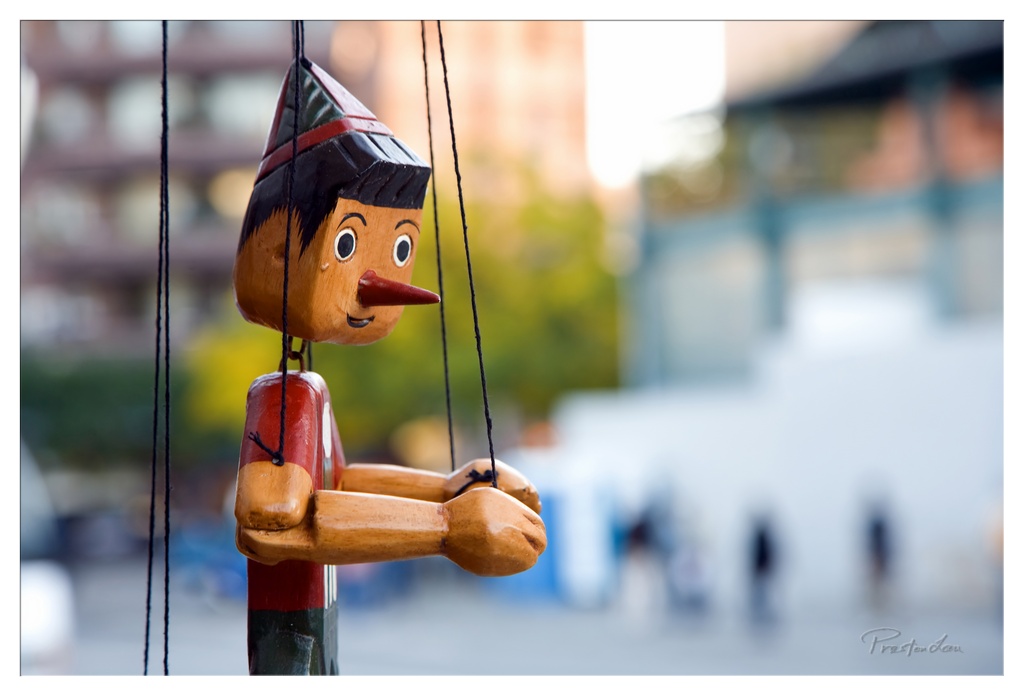

Pinocchio's Predicament
Rating: 8/10
Well, look who it is! Our favorite little wooden fibber, Pinocchio, captured mid-dangle. He seems surprisingly cheerful considering his entire existence is controlled by unseen forces and his nose grows every time he bends the truth – maybe he's just practiced his poker face, or perhaps he's just told a whopping lie right before this shot was taken. Whatever the story, this shot perfectly captures the whimsical, slightly melancholic mood of a puppet caught between reality and the strings that pull him. His painted smile and wide-eyed gaze draw you in, creating a playful yet somewhat static portrait of a classic character.
From a photographic standpoint, this image is a masterclass in subject isolation through shallow depth of field. The bokeh is so creamy it could be whipped, rendering the urban background into abstract blobs of color and light. Compositionally, placing Pinocchio slightly off-center allows the eye to follow the lines of the strings upwards, though maybe a little more space on the left could have balanced it further. The soft natural light beautifully models the textures and colors of the painted wood, making him pop against the dreamy backdrop of blurred buildings and distant, indistinguishable figures who are clearly having a less interesting day than our wooden friend. It's an excellent example of how focusing on a single, well-lit subject can create a compelling narrative even in a busy scene.
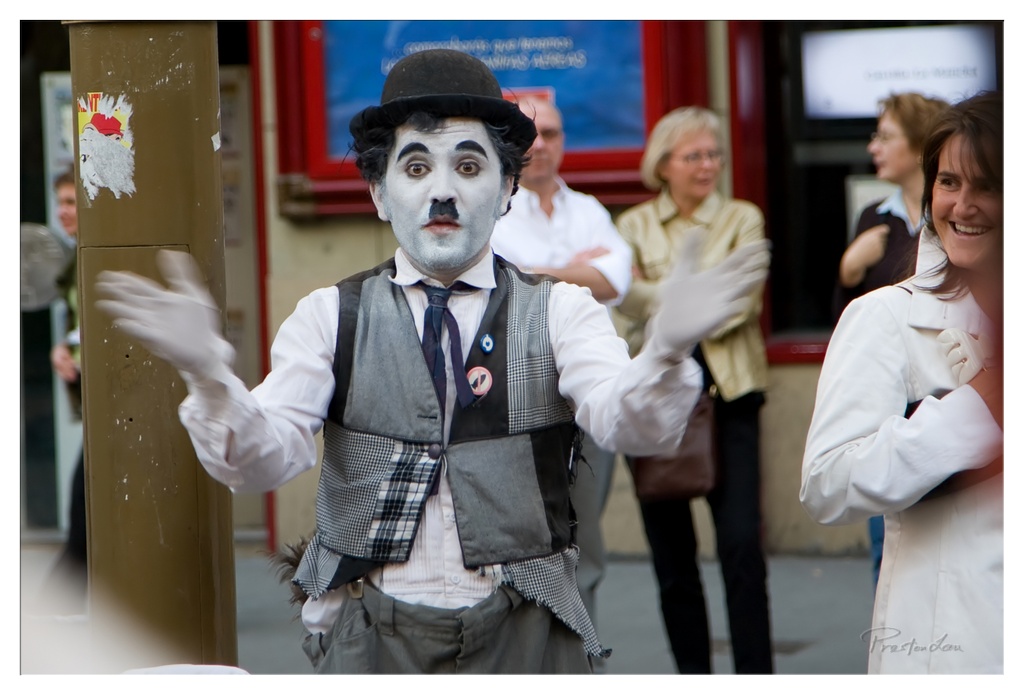

The Street Performer with the Famous Face
Subject Rating: 8/10
Behold, a living, breathing (and presumably performing) tribute to one of cinema's greatest icons! This gentleman has fully committed to the bit, sporting the signature bowler hat, the slightly alarming white face paint, and that instantly recognizable moustache that looks perpetually surprised. His wide-eyed expression and outspread hands suggest he's deep in character, perhaps mid-mime sequence or dramatically reacting to a misplaced banana peel (or just the general chaos of a busy street). The patchwork vest and baggy trousers complete the classic 'Tramp' look, bringing a touch of timeless slapstick charm to the modern urban landscape. It's a fantastic subject, capturing a slice of performance art and cultural homage in a public setting, generating a lively and theatrical mood.
From a technical perspective, the photographer has opted for a candid street portrait style. The composition places the performer slightly off-center, which adds a dynamic feel, although the large pole on the left does create a slight visual anchor that competes with the subject. The use of a shallow depth of field effectively blurs the background, neatly separating the performer from the street scene behind him and keeping the focus squarely on his expressive face and gesture. The natural light is soft and diffused, avoiding harsh shadows and providing even illumination across the face, which is ideal for showcasing the intricate makeup. The color palette is somewhat muted, relying on the greys of the costume and pavement, contrasted effectively by the vibrant red building facade and blue sign in the background. Capturing the woman's reaction smile on the right adds a touch of audience interaction, enhancing the narrative of a street performance. It's a well-executed shot that captures the essence of the subject and the fleeting nature of street art.
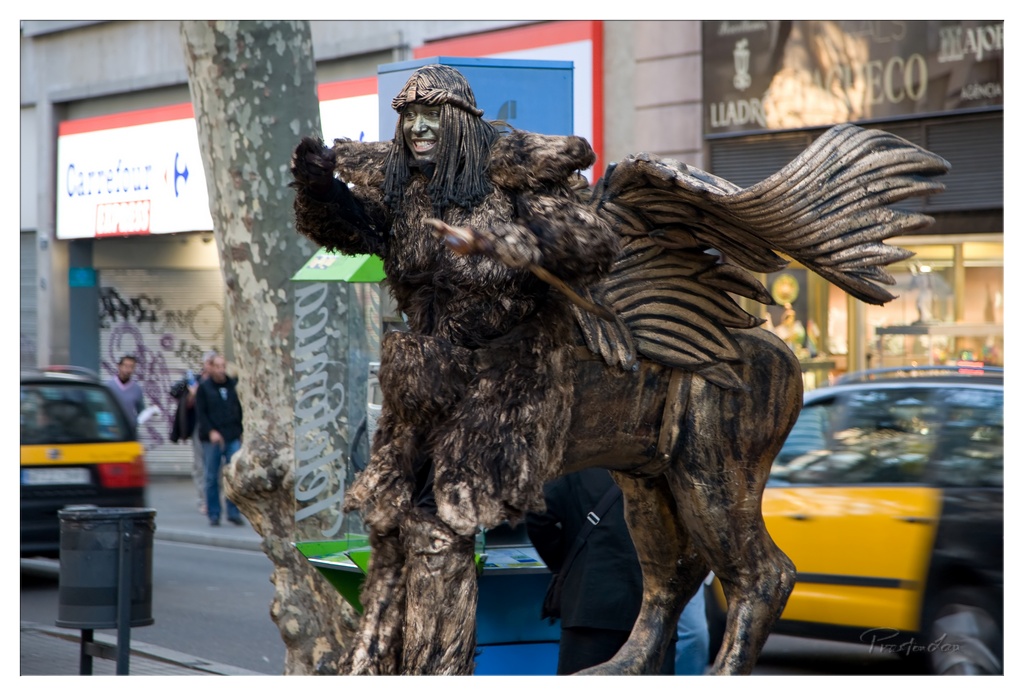

The Golden Guardian of the Gutter
Subject: 8/10
This eye-catching image stars a truly unique street performer, rated an 8/10 for their commitment to looking like a golden, furry, winged beast with an apparent vendetta against... pavement cracks? With a fierce green-painted face and elaborate braided hair, this performer is mid-pose on a bustling street, wings spread wide like they're about to hail a cab or perhaps just demand tribute. The mood is a quirky mix of urban grit and mythological fantasy, creating a slightly surreal scene. The composition places the imposing figure towards the right side of the frame, with a large, textured tree trunk acting as a vertical anchor on the left. The lighting is typical daylight street illumination, decent but not dramatic enough to truly make the gold paint shimmer like dragon scales.
The background provides the gritty urban stage: a busy street with shop fronts, a yellow taxi blurred by motion (a nice touch demonstrating depth of field or a slower shutter speed!), and pedestrians going about their day, seemingly oblivious to the winged menace nearby. Objects like a garbage bin and street furniture add to the everyday context, starkly contrasting with the performer's fantastical getup. While the busy background adds realism, a photography critique might suggest a cleaner frame would better isolate the magnificent subject. However, capturing such an unexpected moment requires reacting quickly to the scene, and this shot successfully freezes the creature in its urban habitat, reminding us that you never know what mythical beings you might bump into on your average shopping trip.
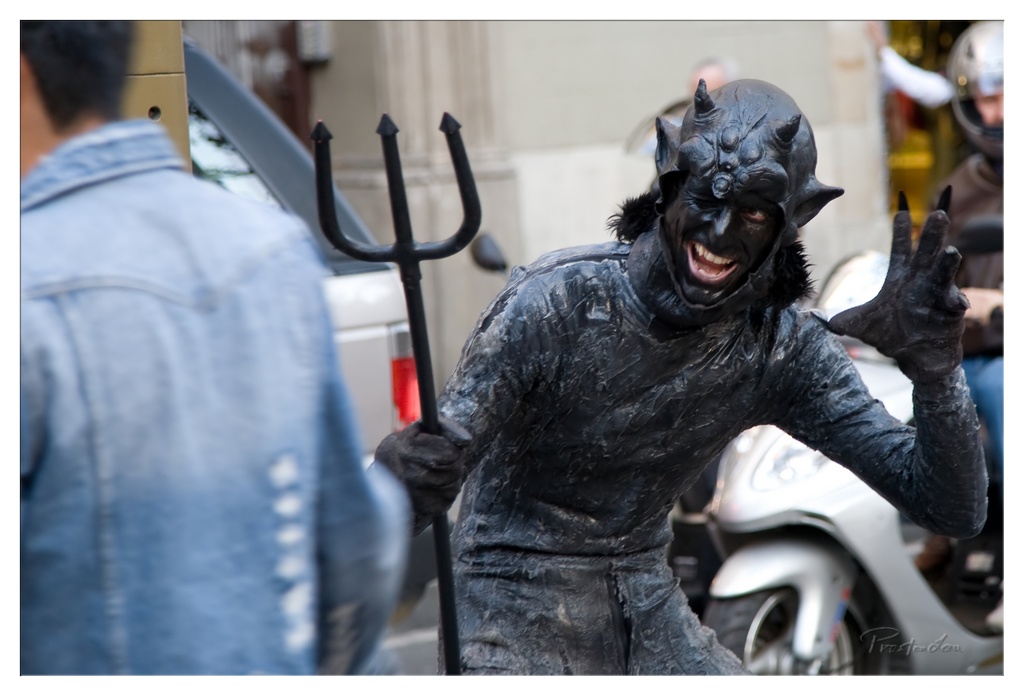

The subject, a remarkably enthusiastic devil street performer, scores a solid 8.5/10 for sheer commitment and terrifying dental hygiene. He's captured mid-pose, trident in hand, sporting a wide, slightly unnerving grin that suggests he's having entirely too much fun on Earth. This image pulsates with a vibrant, slightly mischievous energy, hinting at a moment from a lively public event where costumed characters roam freely. The mood is theatrical and spirited, momentarily suspending the mundane reality of the street scene behind him. It's not every day you see the prince of darkness looking quite so... peppy.
From a photographic perspective, the composition is dynamic, placing the main subject off-center while the imposing black trident helps to anchor the left side of the frame, even with the back of someone's denim jacket intruding slightly on the left edge (perhaps they were trying to photobomb the devil?). The natural lighting, likely from an overcast sky or diffused street light, softly illuminates the heavily textured costume and highlights the sculpted features of the mask, creating depth without harsh shadows. The color palette is dominated by the striking black of the costume and trident against the muted greys, blues, and whites of the background vehicles and buildings, effectively isolating the devil figure as the central focus. This feels like candid street photography, capturing a fleeting, memorable moment with a theatrical flair.
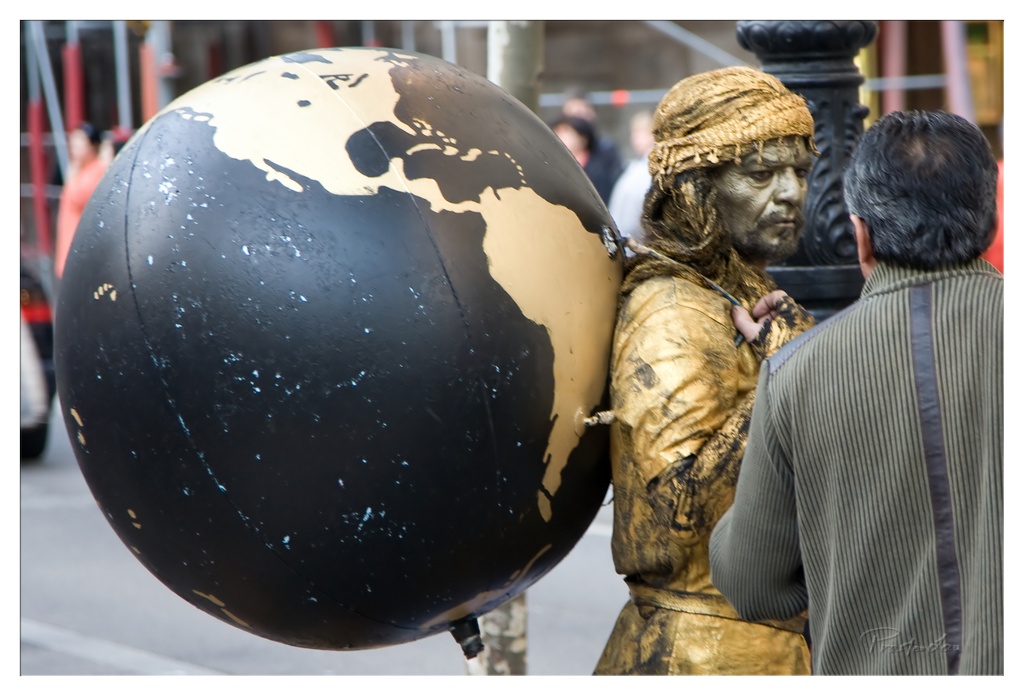

Modern Atlas, Golden Edition
Subject Rating: 9/10
Here we see a captivating street performer, a shimmering figure clad in golden paint, dramatically shouldering a massive black and gold globe. It's impossible not to appreciate the subject's dedication – committing to full-body gold paint and hauling what appears to be a very large, possibly inflatable, planet. This striking portrayal immediately evokes the myth of Atlas, burdened with carrying the weight of the heavens, though this version seems to have traded the celestial sphere for Earth itself. A curious passerby, seen from the back in a rather fetching vertically-striped sweater, engages with the golden man, adding a touch of human interaction to the tableau. The mood is one of curious spectacle, a moment frozen in time on a busy street, highlighting the unusual against the mundane.
From a photographic standpoint, the composition is bold, dominated by the imposing presence of the globe on the left, which feels almost overwhelming but effectively conveys scale. The golden performer and the interlocutor are pushed slightly to the right, creating a somewhat asymmetrical but dynamic frame. The shallow depth of field beautifully isolates the subjects from the blurred background, hinting at a bustling street without distracting from the main event. Lighting appears to be natural outdoor light, which, while a bit strong, does wonders for highlighting the texture and shimmer of the gold paint. The limited color palette, focused on the gold, black, and the muted tones of the bystander and background, helps draw the eye to the central figures and the dramatic prop. It's a strong candid shot that captures the essence of street performance with a touch of metaphorical weight.
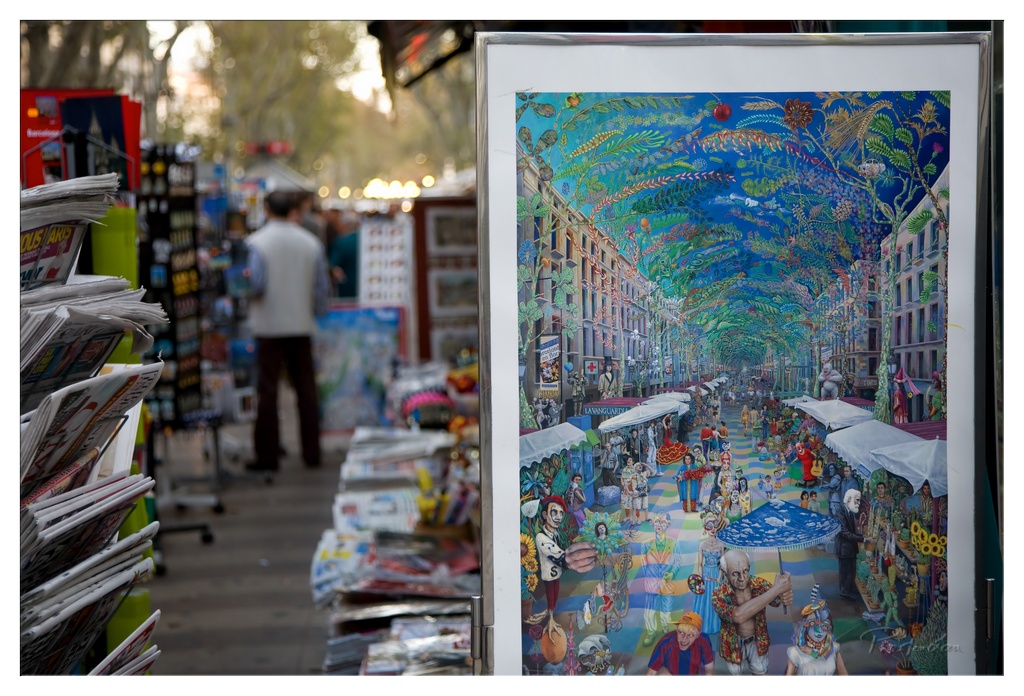

Surreal Street Market Vision
Rating: 9/10 (for the subject's visual intensity)
Behold the glorious visual explosion of this street art! The subject here is a large, intensely detailed print or painting, bursting with color and a fantastical rendition of a bustling urban avenue. It's a fever dream of flora, architecture, and eccentric characters under a sky that looks less like atmosphere and more like a cosmic garden. The mood is undeniably vibrant, almost overwhelming, a stark contrast to the slightly muted reality of the market where it's displayed. You can almost feel the energy radiating from the canvas, pulling you into its strange, busy world, even as the reality of stacked newspapers and blurred stalls grounds the image in a mundane setting. It's a piece designed to stop you in your tracks amidst the everyday hustle.
From a photographic standpoint, the composition is clever, positioning the artwork front and center on the right side, giving it prominence while allowing the blurred market on the left to provide context without distraction. The shallow depth of field is key, expertly isolating the sharp, hyper-detailed painting from the soft, atmospheric background. This contrast in focus mirrors the contrast between the fantasy depicted and the real-world environment. Lighting appears soft and even on the painting, likely benefiting from natural light filtering through the market structure. The muted colors of the background further enhance the painting's riotous palette. It's a well-executed shot that highlights the artwork effectively, proving sometimes the best subject isn't the scene itself, but the art *about* the scene. Just don't stare too long at the painting, or you might start seeing those creatures in the background crowd!
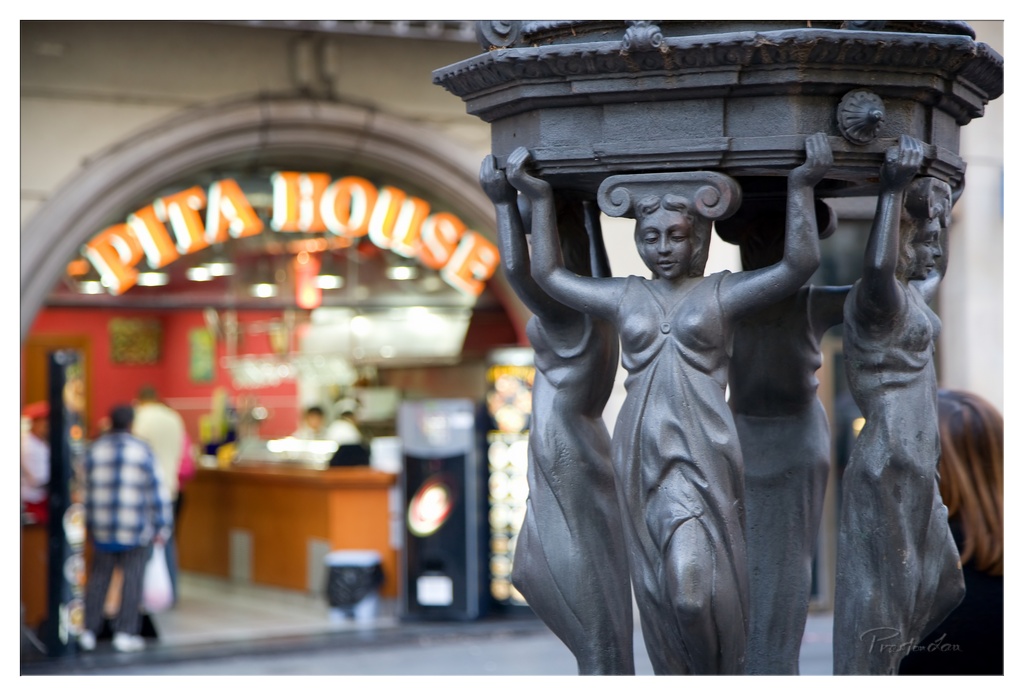

Caryatids and Carb-Loaded Comfort
Rating: 7/10
Behold the urban ballet: on the one side, stoic stone maidens eternally burdened with the weight of... well, something substantial, possibly the lid to a very fancy trash can or a forgotten part of architectural history. Their classical forms are captured in crisp detail, a timeless tableau standing in stark contrast to the vibrant, slightly chaotic scene unfolding just behind them. Through a grand archway, the orange glow of a "Pita House" sign beckons, promising falafel rather than philosophical pondering. Blurred figures hustle and bustle, a snapshot of modern hunger against a backdrop of ancient, unwavering toil. It's a visual metaphor for city life – where epic struggles of form and function meet the urgent need for a quick, satisfying meal.
Photographically, this shot plays a neat trick with juxtaposition and focus. The shallow depth of field is used effectively here, pulling the heavily textured metal statue into sharp relief while blurring the busy background into abstract shapes and light blobs (that lovely bokeh effect!). This technical choice ensures our ancient heroines steal the show, making the Pita House almost a character itself, a hazy dream of deliciousness just beyond their reach. The composition balances the strong vertical lines of the statue with the curved arch of the restaurant entrance, creating visual interest. The lighting is natural and relatively flat, suitable for highlighting the sculptural details without harsh shadows. It's a clever capture that finds unexpected artistry in the everyday urban landscape, proving that even the most profound artistic endeavors can exist alongside the simple pursuit of pita.
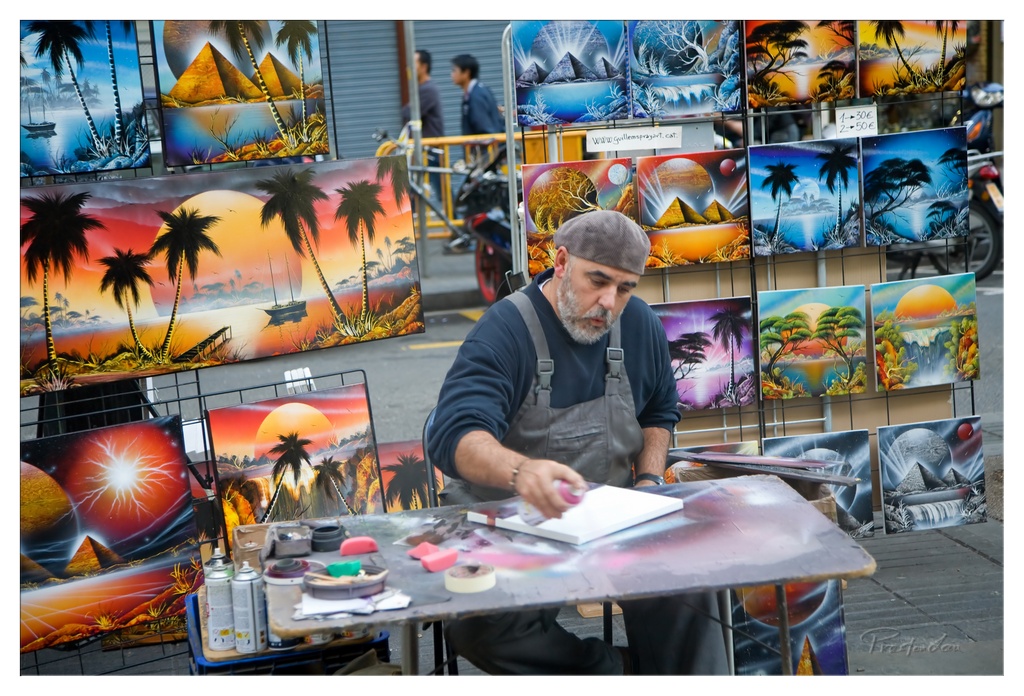

Street Art Spectacle
Subject Rating: 8/10
This bustling image captures a street artist in the midst of his creative process, surrounded by a vibrant display of his work. The artist, wearing a flat cap and weathered overalls, is hunched over a small canvas, applying spray paint with focused intent on a makeshift table littered with tools like spray cans, sponges, and caps. Behind him, a dazzling array of spray-painted canvases are meticulously arranged on wire racks, showcasing recurring themes of exotic landscapes featuring towering palm trees, dramatic sunsets, ancient pyramids reflected in water, and even otherworldly celestial bodies and waterfalls. The style is distinctly spray paint art – characterized by vivid, often neon-like colors, quick techniques to create textures and atmospheric effects, and a certain dramatic, fantastical flair, often targeting tourist tastes. The scene is lively and dynamic, conveying the energy of a street market or fair where artists ply their trade directly for passersby.
From a photographic standpoint, the composition is layered and effective, placing the artist squarely in the foreground, framed by the very art he creates. This allows the viewer's eye to appreciate both the creator and the output simultaneously. The use of depth of field subtly separates the artist and his work from the slightly blurred background, which reveals hints of a busy street with buildings, other people, and even a parked motorcycle, providing crucial context to the scene without being distracting. The lighting appears to be natural daylight, which, while potentially harsh, brilliantly illuminates the intense colors of the spray paintings, making them pop against the artist's more subdued attire and the urban environment. The repetition of similar themes in the surrounding art, while perhaps leaning towards the kitsch side from an artistic perspective, visually reinforces the artist's specialization and creates a compelling backdrop of mass-produced dreams, offering a humorous commentary on the commercial reality of street art.
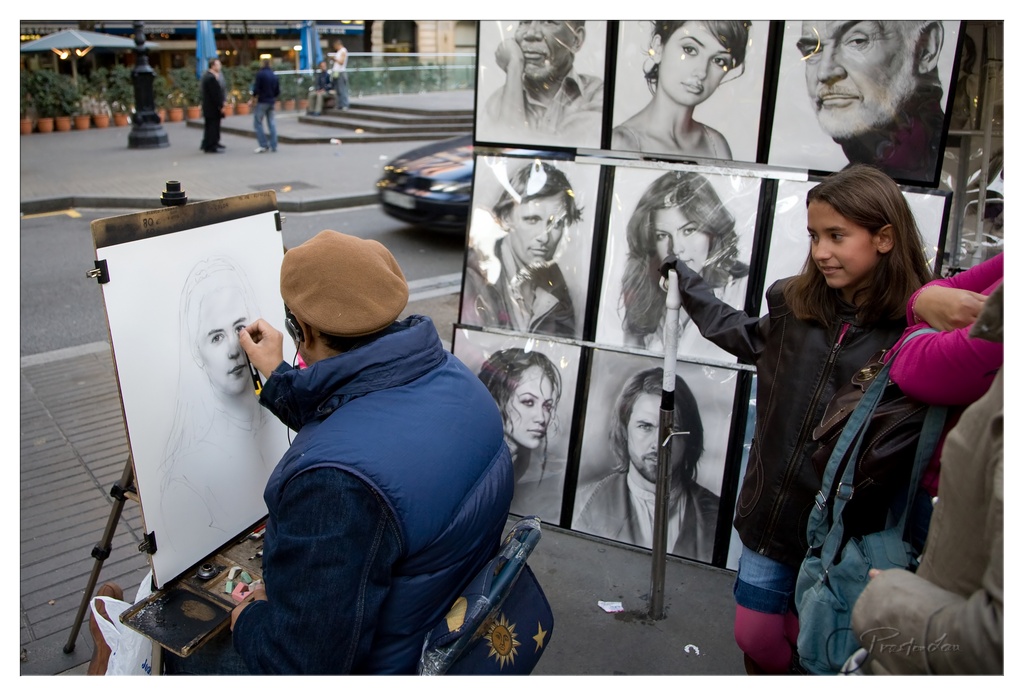

Title: Street Art Spectacle
Subject: 8/10
Step right up folks, witness the magic! Here we have a quintessential street scene featuring an artist deep in the zone, meticulously sketching a portrait on his easel. Sporting a jaunty beret and headphones, he's locked onto his canvas, presumably trying to capture the essence of the sitter, who might be that young lady giving the surrounding celebrity gallery a thoughtful once-over. Beside her, a display rack showcases a familiar line-up of charcoal dream boats and bombshells – think Sean Connery looking distinguished and other beautiful faces that probably never actually sat on this bustling sidewalk. The mood is one of focused creation meeting curious observation, set against the backdrop of a lively urban square complete with distant passersby and the fleeting blur of a car, grounding the artistic endeavor in the flow of everyday life. The scattering of art supplies at the artist's feet adds to the authentic, slightly messy charm of the craft.
From a photographic standpoint, this image is a delightful study in layers and contrasts. The composition effectively draws the eye from the intense focus of the artist and his in-progress drawing on the left to the young observer and the polished finished works on the right, creating a visual dialogue between process and product, reality and idealized image. The natural lighting is soft but effective, highlighting the textures and details without harsh shadows, although those plastic covers on the celebrity portraits are doing their best to introduce some reflective chaos – a common street photography challenge! It's a classic street photography capture – candid, dynamic, and telling a mini-story about the intersection of art, commerce, and public life. One can almost hear the scraping of charcoal and the quiet hum of the city, perhaps wondering if the live portrait will end up looking anything *at all* like the perfect celebrities hanging just inches away.
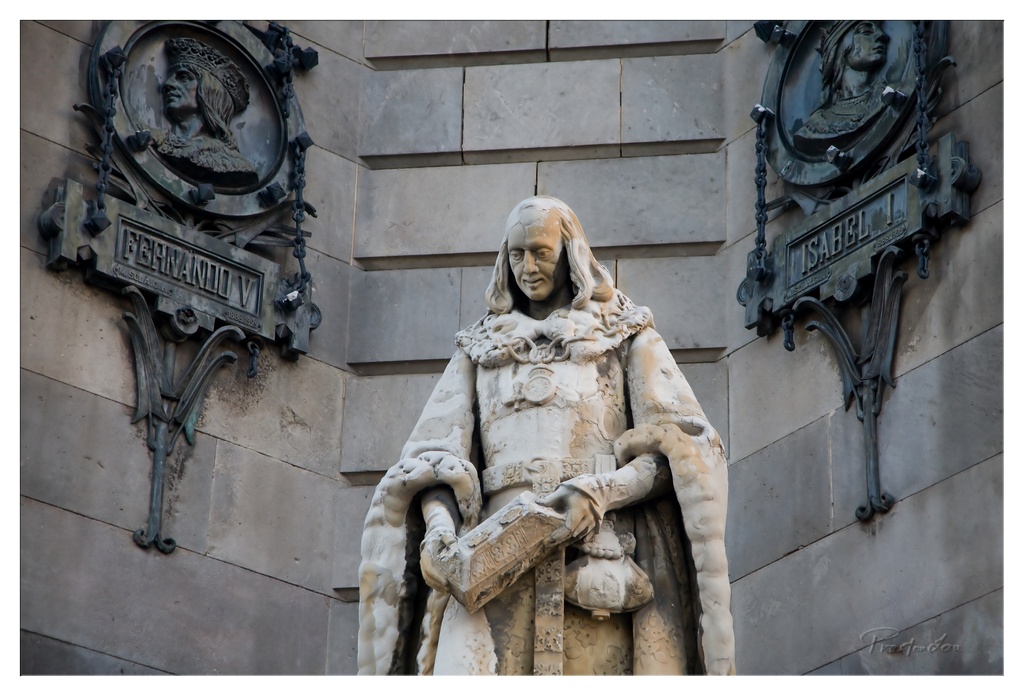

A Trio of Spanish Royalty
Subject Rating: 8/10
This image captures a segment of a historical monument, featuring a central stone statue of a regal figure, flanked by bronze reliefs mounted on a stone wall. The reliefs, clearly labeled "FERNANDO V" and "ISABEL I", depict busts of the famous Spanish monarchs. The central statue, appearing slightly weathered and aged, stands in ornate robes, holding what appears to be a heavy book or tablet in one hand and a distinctively shaped pouch in the other. The mood is decidedly historical and somber, evoking a sense of past power and permanence, underscored by the solid stone construction and the enduring figures depicted. The details on the robes, the faces, and the metalwork are intricate, suggesting a monument of considerable craftsmanship.
From a photographic perspective, the composition is strong, placing the central statue as the primary subject while using the flanking reliefs to provide context and balance. The low angle emphasizes the height and grandeur of the figures. The lighting, likely direct sunlight, is quite harsh, creating strong contrasts and deep shadows, which effectively highlights the texture and wear on the stone and bronze, adding to the sense of age. However, this same harsh light can sometimes flatten facial features. The color palette is dominated by the muted tones of stone and oxidized metal, reinforcing the historical theme. This feels like a deliberate capture of a specific architectural detail, perhaps part of a larger building or monument, presented in a straightforward, almost documentary style, albeit with a dramatic flair from the lighting. The central statue seems perhaps a bit less celebrated than the famous couple beside him, stuck holding a heavy book – maybe a commentary on administrative duties? A solid capture of historical sculpture, though perhaps a slightly softer light would have been kinder to the stony visages.
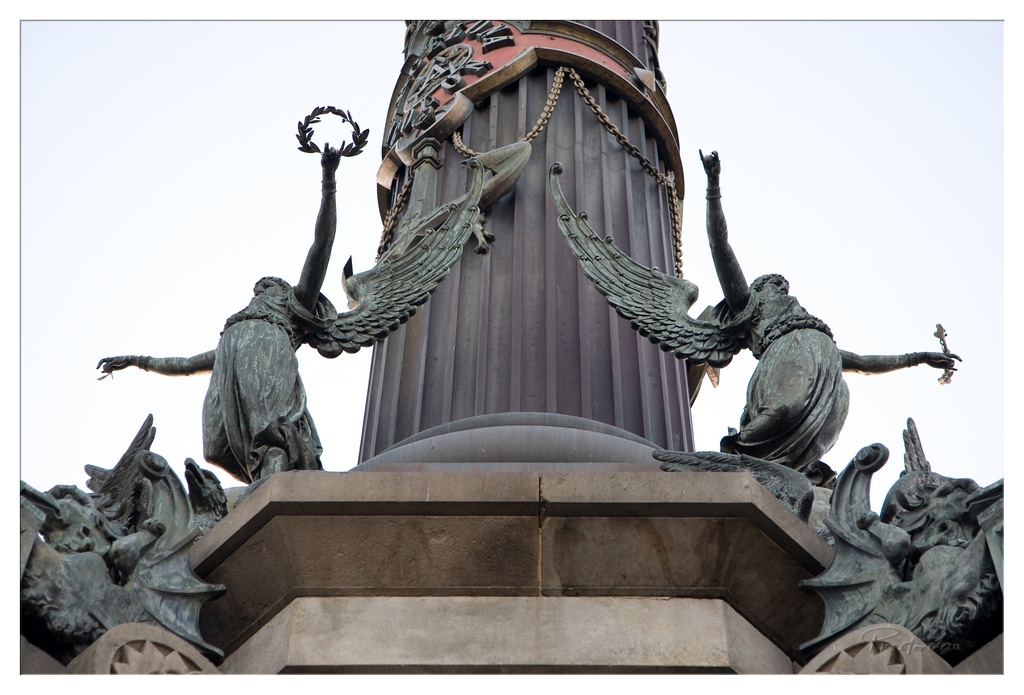

Guardians of the Column
7/10
This close-up shot hones in on the mid-section of a monumental bronze column, where a pair of dramatic winged figures are affixed as if in flight. On the left, a figure holds a laurel wreath aloft, perhaps bestowing honor or victory, while on the right, a similar figure holds an object, possibly a scepter or cross, suggesting dominion or blessing. Their intricate bronze wings spread outwards, mirroring each other across the fluted surface of the column. Below them, glimpses of what appear to be dragons or mythological beasts writhe amongst the architectural details of the monument's base. The low camera angle looks up at the figures, emphasizing their size and placement high above the viewer, giving the entire composition a sense of grandeur and historical weight.
From a photographic standpoint, the choice of a bright, overcast sky provides flat, even lighting which is excellent for revealing the intricate textures and green patina of the bronze sculptures. There are no harsh shadows to obscure details, allowing the craftsmanship of the figures and column to be fully appreciated. However, this also means the sky background is entirely devoid of interest, appearing as a simple white void. The composition crops the monument quite tightly, focusing specifically on this arrangement of figures and the column section, which highlights the detail but loses the overall context of the complete structure. It's a solid study of the sculpture, capturing the dynamic poses and mythological elements effectively, even if the lighting and background are somewhat utilitarian. It makes you wonder what these figures are guarding or celebrating way up there.
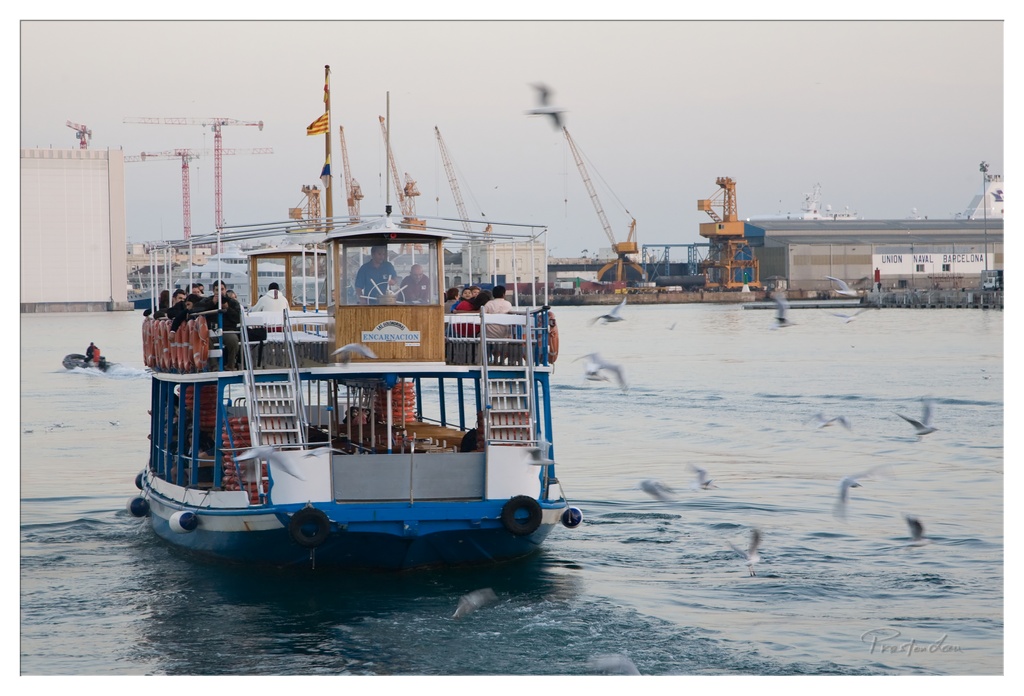

Harbor Cruise Hullabaloo
Subject Rating: 8/10
Ah, the classic tourist ferry, subject rating a solid 8 for its steadfast nautical charm and ability to shuttle folks past impressive industrial vistas. Here, we see the good ship 'Encarnacion' (as proudly displayed on its side, in case you were wondering), chugging along, leaving a foamy wake in its path. It's packed with passengers enjoying a leisurely ride, seemingly oblivious to the aerial ballet happening around them. A flurry of seagulls, perhaps expecting snacks or just enjoying the slipstream, adds chaotic energy to the scene, some rendered as dynamic blurs that capture their flight speed rather than their feathery detail. In the background, the gritty reality of a working port unfolds – giant red and yellow cranes loom over large buildings, including one marked "UNION NAVAL BARCELONA," providing a starkly industrial backdrop to this relaxed maritime excursion. A smaller inflatable boat is also visible in the distance, adding another layer of activity to the watery stage. The overall mood is one of calm transit against a backdrop of industrial power, interspersed with the lively, if somewhat messy, presence of our avian friends.
From a photographic perspective, this shot employs a composition where the ferry dominates the mid-foreground, anchored by its blue hull and the prominent pilot house. The blurry seagulls act as leading lines (or perhaps chaotic vectors) guiding the eye through the frame and emphasizing the motion. The lighting is soft and slightly diffused, suggesting either early morning or late afternoon on a hazy day, which lends itself to the muted color palette dominated by blues, greys, and industrial yellows and reds. While the focus is generally on the boat, the motion blur on the birds is a deliberate choice that adds a sense of movement and life, although it might frustrate those seeking sharp details on every subject. It's a documentary-style capture that tells a story of a typical harbor tour, blending elements of leisure travel with the functional aesthetic of a busy port. The framing successfully includes both the immediate action of the ferry and the broader context of the environment, making it a comprehensive snapshot of the scene. If only those seagulls would hold still for their close-up!
Loading map...